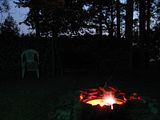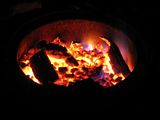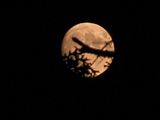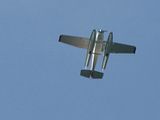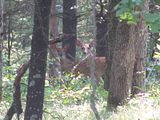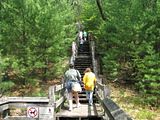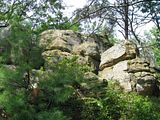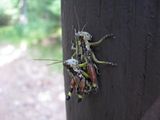1 Sep -3.2 05:39:36 WNW 54
- Quads, hailing from Grand Marsh Observatory atop Elk Castle Hill
Monday, August 31, 2009
The Juneau County Health Department held a Swine Flu planning workshop
The Juneau County Health Department held a H1N1 influenza planning workshop at Mauston City Hall. Several business owners attended...as well as health care providers and school personnel. Juneau County Public Health Nurse and Preparedness Coordinator, Judy Bass, presented the preparedness plan. She wants businesses and individuals to be prepared for the swine flu this fall by getting vaccinated as soon as possible. During the spring...the swine flu caused greater disease in people less than 25-years old. It was very different from the seasonal flu were older individuals are more heavily impacted. The priority groups this fall for the vaccine are pregnant women, children 6-months to 4-years, household contacts of children less than 6-months of age, school aged children and staff at schools, health care and emergency workers, and non-elderly (less than 65-years) with underlying medical conditions. Officials are currently watching the flu trends in the Southern Hemisphere in anticipation of a possible mutation of the H1N1 strain and possible changes in vaccine effectiveness.
source....
source....
Sunday, August 30, 2009
A warning about Photobucket!
Photobucket has destroyed the quality of my photos! And it sounds like a permanent policy change. From http://forums.techguy.org/digital-photography-imaging/845041-photobucket-dramatically-changing-quality-photos.html
Link
- Quads, hailing from Grand Marsh Observatory atop Elk Castle Hill
Link
"I noticed that some of the photos on my account have DRAMATICALLY changed in quality. Which is surprising to me because I keep everything under 1MB, and that's what I have it set up for. Now, it isn't every single picture. It's here and there...but it's annoying because I keep a small portfolio on Photobucket, so the details of the photos matter and they're literally so blurry now I can't see any details at all.
I'm no where near the account limit, and all the pictures are uploaded with the same settings and always under 1MB. Some of the pictures that aren't blurry are actually a HIGHER KB than the ones that are blurry. I even deleted the blurry photos, uploaded them fresh with new names, and they looked great. Then I came back an hour or two later and they were freaking blurry again! What the...!?
I noticed this about 2-3 days ago, and figured it had something to do with Photobucket. Maybe an error or something, because I can recall having this happen before...and after a couple hours the pictures looked normal again. But this has lasted for days...and because only some pictures are affected while others aren't...it's really confusing me."
- Quads, hailing from Grand Marsh Observatory atop Elk Castle Hill
Avoid chimney fires with regular maintenance of wood-burning appliances
Most chimney fires in flues serving wood-burning stoves, fireplace inserts, fireplaces and furnaces occur because of a lack of regular cleaning to remove creosote, which is the residue left behind by unburned fuel. The National Fire Protection Association recommends annual inspection and cleaning as necessary by a professionalchimney sweep. All wood produces creosote, even dry hardwoods.
If a chimney fire occurs, close the damper and doors (if possible, get out of the house, and call the fire department. DO NOT use the chimney until it has been inspected by a Certified Chimney Sweep. Note: Firemen are not trained in evaluating chimney damages. You can tell if a chimney fire is occurring if you hear a loud roaring or freight-train like sound or see flames or sparks coming from the exterior of the chimney at the top or sides, if chimney pipe turns red, or if the appliance suddenly stops drafting. However, most chimney fires occur without the homeowner's knowledge while they are out of the room. Fire damage such as cracked flue liners and blown out mortar joints is usually found during a routine annual inspection by a professional chimney sweep, and these issues make the chimney a potential hazard.
Creosote comes in four forms: Stage 1 is a light dusty coating that comes off easily with brushes, State 2 is a harder and comes in larger pieces but still comes off with heavy brushing, Stage 3 is also known as glazed, baked -on or tar glaze creosote, which is the most flammable type and does not come off with brushes. Glazed creosote bakes on the flue walls and can only be removed by power cleaning with chains or wire brushes on a drill. Removal of this type of creosote is a difficult, time-consuming, and dangerous process, so the best thing to do is avoid the accumulation of Glazed creosote altogether by using proper woodburning habits and having the right chimney or flue for the appliance. The fourth type of creosote is burnt glazed creosote, which occurs when glazed creosote catches fiire and expands to ten times its original size. It has a honeycomb appearance and is very lightweight. Sometimes burnt creosote expands inside the flue, completely or partially choking off draft. This is why sudden smoking of an appliance is an idication of a chimney fire.
Always make sure the correct size flue liner or chimney is being used for the appliance. Open fireplace require large flues, woodburning inserts require very small stainless steel flue liners, and freestanding stoves need small stainless steel chimneys, or if connected to a masonry chimney, a small steel flue liner. The manufacturer of the stove will have information about the best flue size to use. NEVER install a woodburning stove insert into a fireplace with out a stainless steel flue liner. This is the most dangerous type of installation and should be avoided.
Here are some tips for safe wood-burning:
* Don’t burn treated wood, railroad ties, trash, or colored paper since they emit toxic fumes.
* Don’t burn pine trees or railroad ties since they create excessive amounts of flammable creosote and may overheat and warp your steel or cast iron appliance.
* Burning Hedge is also discouraged since it burns very hot and can overheat your woodstove or fireplace. If you must use Hedge, use only one log to every two Oak logs.The best wood to burn is oak because it is very dense and burns slowly. However, any dry hardwood or soft wood may be used – you’ll just have to load the stove more often with soft woods.
* Burn a wood stove hot (400-700 degrees) to assure complete combustion, which is how the stove is designed to be used, and it is cleaner and better for the environment. After establishing the fire, you should see white or clear smoke coming out of the chimney. If the smoke is Grey or black, something is wrong with the wood, your burning methods, or with the chimney system. Stove thermometers are available from your stove retailer.
source....
If a chimney fire occurs, close the damper and doors (if possible, get out of the house, and call the fire department. DO NOT use the chimney until it has been inspected by a Certified Chimney Sweep. Note: Firemen are not trained in evaluating chimney damages. You can tell if a chimney fire is occurring if you hear a loud roaring or freight-train like sound or see flames or sparks coming from the exterior of the chimney at the top or sides, if chimney pipe turns red, or if the appliance suddenly stops drafting. However, most chimney fires occur without the homeowner's knowledge while they are out of the room. Fire damage such as cracked flue liners and blown out mortar joints is usually found during a routine annual inspection by a professional chimney sweep, and these issues make the chimney a potential hazard.
Creosote comes in four forms: Stage 1 is a light dusty coating that comes off easily with brushes, State 2 is a harder and comes in larger pieces but still comes off with heavy brushing, Stage 3 is also known as glazed, baked -on or tar glaze creosote, which is the most flammable type and does not come off with brushes. Glazed creosote bakes on the flue walls and can only be removed by power cleaning with chains or wire brushes on a drill. Removal of this type of creosote is a difficult, time-consuming, and dangerous process, so the best thing to do is avoid the accumulation of Glazed creosote altogether by using proper woodburning habits and having the right chimney or flue for the appliance. The fourth type of creosote is burnt glazed creosote, which occurs when glazed creosote catches fiire and expands to ten times its original size. It has a honeycomb appearance and is very lightweight. Sometimes burnt creosote expands inside the flue, completely or partially choking off draft. This is why sudden smoking of an appliance is an idication of a chimney fire.
Always make sure the correct size flue liner or chimney is being used for the appliance. Open fireplace require large flues, woodburning inserts require very small stainless steel flue liners, and freestanding stoves need small stainless steel chimneys, or if connected to a masonry chimney, a small steel flue liner. The manufacturer of the stove will have information about the best flue size to use. NEVER install a woodburning stove insert into a fireplace with out a stainless steel flue liner. This is the most dangerous type of installation and should be avoided.
Here are some tips for safe wood-burning:
* Don’t burn treated wood, railroad ties, trash, or colored paper since they emit toxic fumes.
* Don’t burn pine trees or railroad ties since they create excessive amounts of flammable creosote and may overheat and warp your steel or cast iron appliance.
* Burning Hedge is also discouraged since it burns very hot and can overheat your woodstove or fireplace. If you must use Hedge, use only one log to every two Oak logs.The best wood to burn is oak because it is very dense and burns slowly. However, any dry hardwood or soft wood may be used – you’ll just have to load the stove more often with soft woods.
* Burn a wood stove hot (400-700 degrees) to assure complete combustion, which is how the stove is designed to be used, and it is cleaner and better for the environment. After establishing the fire, you should see white or clear smoke coming out of the chimney. If the smoke is Grey or black, something is wrong with the wood, your burning methods, or with the chimney system. Stove thermometers are available from your stove retailer.
source....
ISS Tomorrow Morning
31 Aug -2.5 05:14:59 NW 51
- Quads, hailing from Grand Marsh Observatory atop Elk Castle Hill
- Quads, hailing from Grand Marsh Observatory atop Elk Castle Hill
Saturday, August 29, 2009
Black River State Forest Conditions - Conditions as of Friday, August 28, 2009:
All-terrain Vehicle (ATV) Trails
Work is complete on upgrading the wetland crossings on a 1.1-mile section of trail from Wildcat Road heading west. There is some top dressing to be done on the crossings but this work will be done the week after the trails close for the season. Next spring we will focus on upgrading the section of trail between Campground Road and the Clay School Parking Lot.
An example of a recently upgraded section of trail can be found North of the Highway 54 parking lot to Bartos road. These projects will protect the long-term sustainability of the trail system and lessen the frequency of trail closings due to large rainfalls. Over the course of the next two years we hope to upgrade all wetland crossings on the property.
The entire trail system has been groomed within the last two weeks and trails are in good condition.
source....
Work is complete on upgrading the wetland crossings on a 1.1-mile section of trail from Wildcat Road heading west. There is some top dressing to be done on the crossings but this work will be done the week after the trails close for the season. Next spring we will focus on upgrading the section of trail between Campground Road and the Clay School Parking Lot.
An example of a recently upgraded section of trail can be found North of the Highway 54 parking lot to Bartos road. These projects will protect the long-term sustainability of the trail system and lessen the frequency of trail closings due to large rainfalls. Over the course of the next two years we hope to upgrade all wetland crossings on the property.
The entire trail system has been groomed within the last two weeks and trails are in good condition.
source....
Including Wisconsin River & Lake Wisconsin: Statewide sturgeon season opens September 5
The 2009 statewide hook and line, lake sturgeon season opens Saturday, Sept. 5 and runs through Sept. 30. The season bag limit remains at one fish with a minimum size limit of 60”. Anglers who wish to participate will need to buy a ‘harvest tag’, which costs $20 for residents and $50 for non-residents. This tag is not required to fish for sturgeon, but a regular fishing license is required to fish in any water of the State.
If an angler catches a legal size fish and wishes to keep it, a harvest tag must be immediately applied to the fish. Lake Wisconsin and Wisconsin River sturgeon anglers must then take the fish to one of the following registration stations no later than 6:00 p.m. the following day for registration. Current stations include: Dells Area: River’s Edge Resort; Lake Wisconsin Area: Hookers River Stop, Mi Place Bait; Prairie du Sac: Sauk Prairie Live Bait & Tackle.
“The sturgeon fishery is a valuable and unique resource that we watch closely,” noted conservation warden John Buss, Prairie du Sac. He cautions that possession of an illegal or untagged sturgeon is a crime and may result in a fine of $3,000, a mandatory three-year revocation of all DNR licenses and possibly up to 90 days in jail.
It is also illegal to catch a sturgeon for someone else to tag or possess the tag of another person. Anyone who knows of illegal or untagged sturgeon being taken is asked to call the DNR Hotline at 1-800-847-9367 (1-800-TIP-WDNR) or contact the local conservation warden or Sheriff’s Dept. All information will be kept confidential
source....
If an angler catches a legal size fish and wishes to keep it, a harvest tag must be immediately applied to the fish. Lake Wisconsin and Wisconsin River sturgeon anglers must then take the fish to one of the following registration stations no later than 6:00 p.m. the following day for registration. Current stations include: Dells Area: River’s Edge Resort; Lake Wisconsin Area: Hookers River Stop, Mi Place Bait; Prairie du Sac: Sauk Prairie Live Bait & Tackle.
“The sturgeon fishery is a valuable and unique resource that we watch closely,” noted conservation warden John Buss, Prairie du Sac. He cautions that possession of an illegal or untagged sturgeon is a crime and may result in a fine of $3,000, a mandatory three-year revocation of all DNR licenses and possibly up to 90 days in jail.
It is also illegal to catch a sturgeon for someone else to tag or possess the tag of another person. Anyone who knows of illegal or untagged sturgeon being taken is asked to call the DNR Hotline at 1-800-847-9367 (1-800-TIP-WDNR) or contact the local conservation warden or Sheriff’s Dept. All information will be kept confidential
source....
Friday, August 28, 2009
ISS Tomorrow Morning
29 Aug -2.4 06:00:29 NW 49
- Quads, hailing from Grand Marsh Observatory atop Elk Castle Hill
- Quads, hailing from Grand Marsh Observatory atop Elk Castle Hill
U.S. Army Orders More Polaris ATVs
Relationship Drives Company's Growth in Adjacent Market Segments
Polaris Industries Inc. announced the Company received orders from the U.S. Army to provide additional vehicles, parts and accessories of the company's highly successful militarized ATV (All-Terrain Vehicle), the MV700, for operations in Afghanistan. The MV700 already has proven to be a very versatile vehicle in supporting a wide variety of missions conducted in urban, rural, mountain and desert areas worldwide. Values of these orders exceed $6 million and deliveries are planned for later this year.
"Polaris is very proud to continue its role in providing the U.S. Army and its allies with world-class machines that can be relied on to perform under the toughest conditions," said Bennett Morgan, president and chief operating officer of Polaris. “We are very serious about what it takes to be a long-term valued supplier to military and government customers. Polaris Defense works very hard to ensure we are providing a complete capability including; vehicles, spare parts and logistical support for this critical market area.”
For the last five years, Polaris Defense has been supplying a family of vehicles to the U.S. Department of Defense as well as other government agencies and US Allies. Their mission is to provide the U.S. Armed Forces and its allies with the world’s toughest, militarized ATVs and Side-by-Side Vehicles. For more information about Polaris Defense go to www.polarisdefense.com .
source....
Polaris Industries Inc. announced the Company received orders from the U.S. Army to provide additional vehicles, parts and accessories of the company's highly successful militarized ATV (All-Terrain Vehicle), the MV700, for operations in Afghanistan. The MV700 already has proven to be a very versatile vehicle in supporting a wide variety of missions conducted in urban, rural, mountain and desert areas worldwide. Values of these orders exceed $6 million and deliveries are planned for later this year.
"Polaris is very proud to continue its role in providing the U.S. Army and its allies with world-class machines that can be relied on to perform under the toughest conditions," said Bennett Morgan, president and chief operating officer of Polaris. “We are very serious about what it takes to be a long-term valued supplier to military and government customers. Polaris Defense works very hard to ensure we are providing a complete capability including; vehicles, spare parts and logistical support for this critical market area.”
For the last five years, Polaris Defense has been supplying a family of vehicles to the U.S. Department of Defense as well as other government agencies and US Allies. Their mission is to provide the U.S. Armed Forces and its allies with the world’s toughest, militarized ATVs and Side-by-Side Vehicles. For more information about Polaris Defense go to www.polarisdefense.com .
source....
Albireo
Albireo is one of the most beautiful double stars in the night sky. It forms the head of Cygnus, the swan, which is high overhead this evening. Binoculars or a telescope reveal the individual stars. One looks orange, while the other looks blue.
- Quads, hailing from Grand Marsh Observatory atop Elk Castle Hill
- Quads, hailing from Grand Marsh Observatory atop Elk Castle Hill
Thursday, August 27, 2009
On This Day In 1994:
Big Flats Tornado
On the evening of August 27, 1994, the Town of Big Flats was hit by an F3 tornado. It touched down at 8:41 P.M. CDT and was on the ground for 16 minutes. The tornado's path was 10.5 miles (16.9 km) long and 850 yards (780 m) wide.
This tornado killed 2 people when their home was destroyed and 22 people were injured. It also destroyed 24 homes, caused major damage to 8, and 160 had light to moderate damage. In addition, it destroyed the Big Flats Fire Department, the Town Hall, and a thrift store. Seventy cows were also crushed when a barn roof and an upper floor containing 16,000 bails of hay collapsed. This tornado caused $1 million in damage.
- Quads, hailing from Grand Marsh Observatory atop Elk Castle Hill
On the evening of August 27, 1994, the Town of Big Flats was hit by an F3 tornado. It touched down at 8:41 P.M. CDT and was on the ground for 16 minutes. The tornado's path was 10.5 miles (16.9 km) long and 850 yards (780 m) wide.
This tornado killed 2 people when their home was destroyed and 22 people were injured. It also destroyed 24 homes, caused major damage to 8, and 160 had light to moderate damage. In addition, it destroyed the Big Flats Fire Department, the Town Hall, and a thrift store. Seventy cows were also crushed when a barn roof and an upper floor containing 16,000 bails of hay collapsed. This tornado caused $1 million in damage.
- Quads, hailing from Grand Marsh Observatory atop Elk Castle Hill
16 Cygni
The stars of Cygnus, the swan, form the shape of a giant cross. But one of the most intriguing stars in Cygnus is just barely visible to the unaided eye, about 70 light-years away. 16 Cygni is a family of at least three stars, one of which has a planet.
- Quads, hailing from Grand Marsh Observatory atop Elk Castle Hill
- Quads, hailing from Grand Marsh Observatory atop Elk Castle Hill
Wednesday, August 26, 2009
zones of darkness
The Milky Way arcs high overhead tonight. This hazy band of stars is divided by giant clouds of dust that form dark rifts. These zones of darkness conceal some of the biggest, brightest stars in the galaxy.
- Quads, hailing from Grand Marsh Observatory atop Elk Castle Hill
- Quads, hailing from Grand Marsh Observatory atop Elk Castle Hill
Couple: ‘Squirrel crasher’ pic ‘100 percent’ real
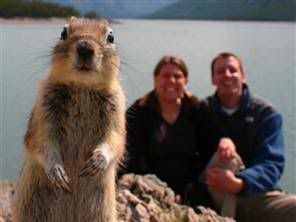
‘Whole world is laughing’ at curious critter who popped up in vacation photo
It was the perfect backdrop for a vacation photo — a gorgeous mountain lake with a rocky shore and a big Canadian sky. It was the sort of shot that a couple put in their personal album and share with their family and friends for years.
And then the squirrel popped up.
Since you have an Internet connection, you’ve probably seen the shot of the camera-hog squirrel stealing the scene — and the hearts of people around the world.
And, contrary to reservations TODAY’s Matt Lauer expressed on the air last Friday, it’s not fake.
“It’s 100 percent undoctored,” Melissa Brandts told Lauer Monday from Minneapolis.
Faced with Melissa and her husband, Jackson Brandts, Lauer tried his best to weasel out of his skeptical comments of last week. “I can’t be the only one who questioned the authenticity of that, right?” he asked, somewhat hopefully.
“You questioned it on national TV,” Melissa said with a laugh.
The whole world is laughing
The 29-year-old pediatric nurse and her mechanical engineer husband, also 29, have a lot to smile about these days. In just two weeks, they’re expecting their first child. And, since Aug. 4, when they sent the serendipitous picture of them and their squirrelly friend to a National Geographic photo contest, they’ve found themselves in newspapers from Korea to their hometown of Minneapolis.
“We just have been laughing about it for months — and now the world is laughing, too,” Melissa said.
The story of the nutty squirrel goes back to May when Jackson and Melissa, who love camping, took a trip to Canada’s Banff National Park. While hiking at Lake Minnewanka, Melissa spotted a perfect spot on the rocks for a nice vacation picture.
Melissa sat down while Jackson set up their camera on a small tripod on the rocks. As her husband fiddled with the camera, a curious — and bold — squirrel popped out of the rocks and started scampering all around, including over Melissa’s feet. She laughed about it and told her husband she hoped he was friendly.
Was he ever!
The camera had a self-timer as well as a remote shutter release, which Jackson held in his right hand. He settled himself on the rocks, snuggling next to his wife with his right arm around her shoulder and fired off a few pictures of just the two of them, smiling and posing.
“As we started taking the pictures, he ducked down into the rocks,” Melissa told Lauer and Curry. “And then he heard the shutter release and became interested; thought perhaps it was going to give him some food.”
The squirrel adopted a pose reminiscent of the groundhog in “Caddyshack,” paws held at chest level, eyes staring dead at the camera.
“We were laughing so hard saying, ‘Quick, get it, get it, get it, get it!’ We took a whole series of photos not knowing what we were going to get. And you saw what we got,” Melissa said as the now-iconic shot played on the monitor.
The couple looked at the pictures on the camera’s small monitor, but had no idea if they were in focus. It was only when they got back to their room and downloaded them onto a computer that they saw that the camera’s autofocus mechanism had locked onto the squirrel, leaving the laughing pair blurred in the background.
“It was just really a real fun moment for us. We brought it back and our friends and family just all could not believe it,” Melissa said.
A star is born
Months later, she saw that National Geographic was soliciting photos on its “Your Shot” Web site. Feeling that others would enjoy the shot, she sent it in.
That was on Aug, 4. The next thing Melissa and Jackson knew, the picture was on the front page of a newspaper in Korea and they (well, the squirrel, actually) were an international Internet sensation.
And Lauer was questioning them on national television.
The TODAY host said he was sorry for ever doubting the Brandtses and their furry friend.
“I apologize. Now that I see the pictures that led up to this picture, I have no doubt that this picture is authentic and I will never question the two of you again on national TV,” he promised.
But Curry had one more question. Given the celebrity they’ve gained from their picture and the fact that Melissa is due to deliver shortly, “Any thought about naming your baby Rocky?”
“No,” the laughing father-to-be replied. “We need a real name.”
source....
Tuesday, August 25, 2009
Crop circles lure visitors to Wilbur, Wash.
The Chamber of Commerce in Wilbur paused last year to give special thanks to an uncommon type of visitor who doesn't come around much but makes each visit count.
"Thanks to the Aliens who made Wilbur their Vacation Destination!" reads an award of appreciation.
Wilbur, a no-stoplight wheat town (population 960) 65 miles west of Spokane, is on the way to becoming the Northwest's hub for the extraterrestrial-obsessed. For the second time in three years, crop circles have mysteriously appeared in wheat fields, generating curiosity, jokes and coffee-shop debates of the "Big Question."
The most recent appeared in late July on a remote hillside of the Haden family wheat farm just south of Wilbur. Five rings of declining size, plus one circle, were crushed into ripe wheat. "This is the one where they put the spaceship landing pad down," said Keith Haden, pointing to the circle, and struggling to keep a straight face.
His friendly skepticism is the prevailing local mood. Depending on your belief in the supernatural, crop circles are either a mysterious sign of extraterrestrial contact or a clever hoax that has risen in popularity since the mid-1970s. Southern England has been ground zero, but at least three formations have been reported in Eastern Washington farmland since 1993.
Before Haden's formation, the most recent and celebrated was an elaborate set of nine circles found in June 2007, amid 120 acres of green wheat northwest of Wilbur. That sighting was widely reported, and the Llewellyn farm was soon inundated with out-of-state tourists in saris and tinfoil-covered helmets, scientific researchers from the University of Washington and — in at least one case — a group of naked dancers. Billy Burger, a local institution, put an Alien Burger and Invasion Fries on the menu.
"I thought the less you said, the more it would go away," said Jim Llewellyn, owner of the farm. "But the next thing, there were planes flying overhead and people all over the place. It spread like wildfire."
Looking for signs
Craig Haden, owner of the land where the most recent crop circle was found, hoped to avoid such a scene. After seeing the circles while inspecting his land on a motorcycle, he told his son, Braidy. They found no sign of tracks through the ripe wheat or footprints between the rows.
"It makes you think," said Braidy Haden, a 23-year-old wearing striped overalls and sporting a soul patch.
The sighting wasn't widely reported, but word leaked out locally and ad hoc roads soon were cut through the fields. A woman recently dropped by with a metal detector. Keith Haden, Craig's brother, offered the woman's husband the tinfoil hat that a friend had dropped off.
Among the people who arrived was Peter Davenport, who runs the National UFO Reporting Center from a former military missile bunker in nearby Davenport.
"As to whether it is a genuine formation, I am not able to pass judgment with any certainty," he said. The wheat stalks at the Haden crop circles were sharply crimped and the formation's edges were ragged, both signs it was man-made.
But the Llewellyn crop circle, Davenport said, was "very interesting." A team from BLT Research Team, a Cambridge, Mass.-based group that investigates crop circles, came away believing it was the "real McCoy," according to a summary of its research on the group's Web site. Among the evidence: bent — not crimped — stalks and cavities blown out of the wheat stalks, interpreted to mean they had been pushed down by a pulse of energy.
The researchers made a case that "makes a skeptic like me think," Llewellyn said, talking on his cellphone from his combine. "It wasn't the high-school kids from Wilbur. This was a professional job, somebody who knew what they were doing."
Debunking the mystery
Joe Nickell, a former magician, has investigated crop circles for decades and has a conclusion:. "One hundred and two percent of crop circles are fake," said Nickell, a writer for Skeptical Inquirer magazine, in Amherst, N.Y.
Two British hoaxers admitted in 1991 they came up with the idea at a pub decades earlier. Their techniques have been replicated for a Discovery Channel documentary that sought to debunk the mystery. Massachusetts Institute of Technology scientists found similarities between unexplained formations and crop circles known to be man-made.
There will be no such tests on the Haden crop circle because the Hadens plowed the field last week. "The combine levitated as I went over it; the electric instruments went haywire," said Braidy Haden, with a straight face.
The night after it was found, he and a buddy drove out to the formation at night to look for unexplained lights. When their headlights crossed the reflectors of an old piece of farm equipment, the pair jumped. "Scared the hell out of us," he said.
On a tour of the field this week, the circles — the largest at 120 feet across — were visible amid the stubble. Braidy and Keith Haden wondered how the circles were made so straight, how the equipment was brought in and how they were made without leaving tracks.
"It'd be tough to do," said Braidy Haden. "I'd like to get some friends together and give it a try."
source....
"Thanks to the Aliens who made Wilbur their Vacation Destination!" reads an award of appreciation.
Wilbur, a no-stoplight wheat town (population 960) 65 miles west of Spokane, is on the way to becoming the Northwest's hub for the extraterrestrial-obsessed. For the second time in three years, crop circles have mysteriously appeared in wheat fields, generating curiosity, jokes and coffee-shop debates of the "Big Question."
The most recent appeared in late July on a remote hillside of the Haden family wheat farm just south of Wilbur. Five rings of declining size, plus one circle, were crushed into ripe wheat. "This is the one where they put the spaceship landing pad down," said Keith Haden, pointing to the circle, and struggling to keep a straight face.
His friendly skepticism is the prevailing local mood. Depending on your belief in the supernatural, crop circles are either a mysterious sign of extraterrestrial contact or a clever hoax that has risen in popularity since the mid-1970s. Southern England has been ground zero, but at least three formations have been reported in Eastern Washington farmland since 1993.
Before Haden's formation, the most recent and celebrated was an elaborate set of nine circles found in June 2007, amid 120 acres of green wheat northwest of Wilbur. That sighting was widely reported, and the Llewellyn farm was soon inundated with out-of-state tourists in saris and tinfoil-covered helmets, scientific researchers from the University of Washington and — in at least one case — a group of naked dancers. Billy Burger, a local institution, put an Alien Burger and Invasion Fries on the menu.
"I thought the less you said, the more it would go away," said Jim Llewellyn, owner of the farm. "But the next thing, there were planes flying overhead and people all over the place. It spread like wildfire."
Looking for signs
Craig Haden, owner of the land where the most recent crop circle was found, hoped to avoid such a scene. After seeing the circles while inspecting his land on a motorcycle, he told his son, Braidy. They found no sign of tracks through the ripe wheat or footprints between the rows.
"It makes you think," said Braidy Haden, a 23-year-old wearing striped overalls and sporting a soul patch.
The sighting wasn't widely reported, but word leaked out locally and ad hoc roads soon were cut through the fields. A woman recently dropped by with a metal detector. Keith Haden, Craig's brother, offered the woman's husband the tinfoil hat that a friend had dropped off.
Among the people who arrived was Peter Davenport, who runs the National UFO Reporting Center from a former military missile bunker in nearby Davenport.
"As to whether it is a genuine formation, I am not able to pass judgment with any certainty," he said. The wheat stalks at the Haden crop circles were sharply crimped and the formation's edges were ragged, both signs it was man-made.
But the Llewellyn crop circle, Davenport said, was "very interesting." A team from BLT Research Team, a Cambridge, Mass.-based group that investigates crop circles, came away believing it was the "real McCoy," according to a summary of its research on the group's Web site. Among the evidence: bent — not crimped — stalks and cavities blown out of the wheat stalks, interpreted to mean they had been pushed down by a pulse of energy.
The researchers made a case that "makes a skeptic like me think," Llewellyn said, talking on his cellphone from his combine. "It wasn't the high-school kids from Wilbur. This was a professional job, somebody who knew what they were doing."
Debunking the mystery
Joe Nickell, a former magician, has investigated crop circles for decades and has a conclusion:. "One hundred and two percent of crop circles are fake," said Nickell, a writer for Skeptical Inquirer magazine, in Amherst, N.Y.
Two British hoaxers admitted in 1991 they came up with the idea at a pub decades earlier. Their techniques have been replicated for a Discovery Channel documentary that sought to debunk the mystery. Massachusetts Institute of Technology scientists found similarities between unexplained formations and crop circles known to be man-made.
There will be no such tests on the Haden crop circle because the Hadens plowed the field last week. "The combine levitated as I went over it; the electric instruments went haywire," said Braidy Haden, with a straight face.
The night after it was found, he and a buddy drove out to the formation at night to look for unexplained lights. When their headlights crossed the reflectors of an old piece of farm equipment, the pair jumped. "Scared the hell out of us," he said.
On a tour of the field this week, the circles — the largest at 120 feet across — were visible amid the stubble. Braidy and Keith Haden wondered how the circles were made so straight, how the equipment was brought in and how they were made without leaving tracks.
"It'd be tough to do," said Braidy Haden. "I'd like to get some friends together and give it a try."
source....
Monday, August 24, 2009
US probe captures Saturn equinox
Raw images of the moment Saturn reached its equinox have been beamed to Earth by the US Cassini spacecraft.
Scientists are studying the unprocessed pictures to uncover new discoveries in the gas giant's ring system.
Equinox is the moment when the Sun crosses a planet's equator, making day and night the same length.
During this time, the Sun's angle over Saturn is lowered, showing new objects and irregular structures as shadows on the otherwise flat plane of the rings.
Saturn's orbit is so vast that Equinox happens only once every 15 Earth years.
At the moment of equinox, the rings turn edge-on to the Sun and reflect almost no sunlight.
This is the first equinox since 1994 and the first time there has been an observer, in the shape of the joint US and European spacecraft, Cassini.
In an email, Dr Carolyn Porco, leader of Cassini's imaging team, said the long-awaited images did not disappoint: "Even a cursory examination of them reveals strange new phenomena we hadn't fully anticipated.
"Over the next week or two, the [Cassini] imaging team will be poring over these precious gems to see what other surprises await us, and, as usual, we will announce what we have found as soon as we can."
Cassini was launched in October 1997 from Florida's Cape Canaveral Air Force Station. It arrived at Saturn in July 2004 to embark on a four-year mission of exploration around the planet and its moons.
The spacecraft is still operating well and has been re-programmed to carry out new tasks. Its current mission is to answer some of the questions raised by its earlier observations.
source....
Scientists are studying the unprocessed pictures to uncover new discoveries in the gas giant's ring system.
Equinox is the moment when the Sun crosses a planet's equator, making day and night the same length.
During this time, the Sun's angle over Saturn is lowered, showing new objects and irregular structures as shadows on the otherwise flat plane of the rings.
Saturn's orbit is so vast that Equinox happens only once every 15 Earth years.
At the moment of equinox, the rings turn edge-on to the Sun and reflect almost no sunlight.
This is the first equinox since 1994 and the first time there has been an observer, in the shape of the joint US and European spacecraft, Cassini.
In an email, Dr Carolyn Porco, leader of Cassini's imaging team, said the long-awaited images did not disappoint: "Even a cursory examination of them reveals strange new phenomena we hadn't fully anticipated.
"Over the next week or two, the [Cassini] imaging team will be poring over these precious gems to see what other surprises await us, and, as usual, we will announce what we have found as soon as we can."
Cassini was launched in October 1997 from Florida's Cape Canaveral Air Force Station. It arrived at Saturn in July 2004 to embark on a four-year mission of exploration around the planet and its moons.
The spacecraft is still operating well and has been re-programmed to carry out new tasks. Its current mission is to answer some of the questions raised by its earlier observations.
source....
Cygnus, the swan
Cygnus, the swan, flies high overhead on summer nights, its body and wings immersed in the Milky Way. It is easy to pick out because it really does look like a bird, and because the star at its tail is one of the brightest in the night sky.
- Quads, hailing from Grand Marsh Observatory atop Elk Castle Hill
- Quads, hailing from Grand Marsh Observatory atop Elk Castle Hill
Sunday, August 23, 2009
News From The Observatory - A 2 Million Year Old Picture


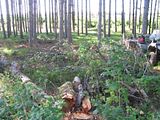

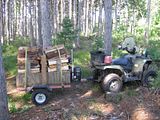
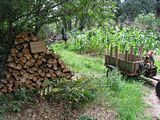
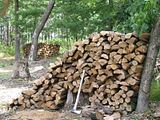
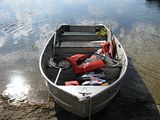
- Quads, hailing from Grand Marsh Observatory atop Elk Castle Hill
Brittany's Birthday Party!

Happy birthday Brittany! I hope you had as much fun at your birthday party as I did!
It sure was fun to get out and away from home for awhile last night. Had a great time running my mouth off with my old pals! And just when Russell got there and it was getting to be really wild, the old lady told me it was time to go home. Damn.
- Quads, hailing from Grand Marsh Observatory atop Elk Castle Hill
Skydiver survives 10,000ft fall to the ground
Paul Lewis, 40, jumped from a plane and plummeted through the air before crashing on to the roof of a hangar at Tilstock Airfield in Whitchurch, Shropshire.
He was rescued by firefighters and treated for head and neck injuries, before being airlifted to the University Hospital of North Staffordshire, in Stoke-on-Trent.
The accident happened at around 3pm on Friday when Mr Lewis, a freelance cameraman, was filming tandem jumps for the Parachute Centre, a skydiving firm based at the airfield.
Witnesses said that his main parachute failed to open, and then his reserve parachute failed to work properly.
A spokesman for the West Midlands Ambulance Service, said: “The man is reported to have fallen approximately 1,000 feet (3,000 metres), spiralling to the ground following a 10,000-foot skydive.”
Colin Fitzmorris, who owns the Parachute Centre, said that Mr Lewis was “very lucky” to escape without more serious injuries, and is expected to make a full recovery.
Mr Fitzmorris, who saw the accident happen, said: “He had a malfunction on his main parachute, which he cut away normally, but had some kind of control problem on his reserve which continued to spiral until he hit the hangar roof.
“The roof of the hangar broke his fall and flexed sufficiently to reduce the impact. He has no fractures but some neck injury, and we are sure that he will make a full recovery. He is very lucky.”
Tracey Butterworth, a care worker from Leek, Staffordshire, who performed a tandem jump videoed by Mr Lewis last month, said: “He’s a fantastic bloke – he and the other instructor made the day for me.
“He was making me laugh from start to finish, and always very professional. It sounds like he’s been very, very lucky and I’m glad to hear he’s OK.”
On his Facebook site, Mr Lewis, who is thought to live in Shropshire, lists his interests as skydiving; the pop band My Left Foot; the television sit-com Father Ted; and Peter Griffin, the character from the animated television series Family Guy.
In 2007, experienced parachutist Michael Holmes survived after his main canopy and reserve failed to open after a 12,000ft jump.
Triggered at 4,000ft above Lake Taupo, New Zealand, the malfunction was caught in a gut-wrenching video sequence by his head-mounted camera.
Mr Holmes, from Jersey, had his fall broken by a tree. He suffered only a punctured lung and a broken ankle.
The person to have fallen the greatest distance without a parachute, and survived, is Vesna Vulović, a Serbian air hostess who fell 33,000ft after her JAT airliner was blown up in January 1972.
The 22-year-old landed in snow in the former Czechoslovakia.
source....
He was rescued by firefighters and treated for head and neck injuries, before being airlifted to the University Hospital of North Staffordshire, in Stoke-on-Trent.
The accident happened at around 3pm on Friday when Mr Lewis, a freelance cameraman, was filming tandem jumps for the Parachute Centre, a skydiving firm based at the airfield.
Witnesses said that his main parachute failed to open, and then his reserve parachute failed to work properly.
A spokesman for the West Midlands Ambulance Service, said: “The man is reported to have fallen approximately 1,000 feet (3,000 metres), spiralling to the ground following a 10,000-foot skydive.”
Colin Fitzmorris, who owns the Parachute Centre, said that Mr Lewis was “very lucky” to escape without more serious injuries, and is expected to make a full recovery.
Mr Fitzmorris, who saw the accident happen, said: “He had a malfunction on his main parachute, which he cut away normally, but had some kind of control problem on his reserve which continued to spiral until he hit the hangar roof.
“The roof of the hangar broke his fall and flexed sufficiently to reduce the impact. He has no fractures but some neck injury, and we are sure that he will make a full recovery. He is very lucky.”
Tracey Butterworth, a care worker from Leek, Staffordshire, who performed a tandem jump videoed by Mr Lewis last month, said: “He’s a fantastic bloke – he and the other instructor made the day for me.
“He was making me laugh from start to finish, and always very professional. It sounds like he’s been very, very lucky and I’m glad to hear he’s OK.”
On his Facebook site, Mr Lewis, who is thought to live in Shropshire, lists his interests as skydiving; the pop band My Left Foot; the television sit-com Father Ted; and Peter Griffin, the character from the animated television series Family Guy.
In 2007, experienced parachutist Michael Holmes survived after his main canopy and reserve failed to open after a 12,000ft jump.
Triggered at 4,000ft above Lake Taupo, New Zealand, the malfunction was caught in a gut-wrenching video sequence by his head-mounted camera.
Mr Holmes, from Jersey, had his fall broken by a tree. He suffered only a punctured lung and a broken ankle.
The person to have fallen the greatest distance without a parachute, and survived, is Vesna Vulović, a Serbian air hostess who fell 33,000ft after her JAT airliner was blown up in January 1972.
The 22-year-old landed in snow in the former Czechoslovakia.
source....
ISS Tomorrow Morning
24 Aug -1.6 03:57:48 NNE 31
- Quads, hailing from Grand Marsh Observatory atop Elk Castle Hill
- Quads, hailing from Grand Marsh Observatory atop Elk Castle Hill
Saturday, August 22, 2009
Swine flu vaccine link to killer nerve disease: Leaked letter reveals concern of neurologists over 25 deaths in America
A warning that the new swine flu vaccine is linked to a deadly nerve disease has been sent by the Government to senior neurologists in a confidential letter.
The letter from the Health Protection Agency, the official body that oversees public health, has been leaked to The Mail on Sunday, leading to demands to know why the information has not been given to the public before the vaccination of millions of people, including children, begins.
It tells the neurologists that they must be alert for an increase in a brain disorder called Guillain-Barre Syndrome (GBS), which could be triggered by the vaccine.
GBS attacks the lining of the nerves, causing paralysis and inability to breathe, and can be fatal.
The letter, sent to about 600 neurologists on July 29, is the first sign that there is concern at the highest levels that the vaccine itself could cause serious complications.
It refers to the use of a similar swine flu vaccine in the United States in 1976 when:
* More people died from the vaccination than from swine flu.
* 500 cases of GBS were detected.
* The vaccine may have increased the risk of contracting GBS by eight times.
* The vaccine was withdrawn after just ten weeks when the link with GBS became clear.
* The US Government was forced to pay out millions of dollars to those affected.
Concerns have already been raised that the new vaccine has not been sufficiently tested and that the effects, especially on children, are unknown.
It is being developed by pharmaceutical companies and will be given to about 13million people during the first wave of immunisation, expected to start in October.
Top priority will be given to everyone aged six months to 65 with an underlying health problem, pregnant women and health professionals.
The British Neurological Surveillance Unit (BNSU), part of the British Association of Neurologists, has been asked to monitor closely any cases of GBS as the vaccine is rolled out.
One senior neurologist said last night: ‘I would not have the swine
flu jab because of the GBS risk.’
There are concerns that there could be a repeat of what became known as the ‘1976 debacle’ in the US, where a swine flu vaccine killed 25 people – more than the virus itself.
source....
The letter from the Health Protection Agency, the official body that oversees public health, has been leaked to The Mail on Sunday, leading to demands to know why the information has not been given to the public before the vaccination of millions of people, including children, begins.
It tells the neurologists that they must be alert for an increase in a brain disorder called Guillain-Barre Syndrome (GBS), which could be triggered by the vaccine.
GBS attacks the lining of the nerves, causing paralysis and inability to breathe, and can be fatal.
The letter, sent to about 600 neurologists on July 29, is the first sign that there is concern at the highest levels that the vaccine itself could cause serious complications.
It refers to the use of a similar swine flu vaccine in the United States in 1976 when:
* More people died from the vaccination than from swine flu.
* 500 cases of GBS were detected.
* The vaccine may have increased the risk of contracting GBS by eight times.
* The vaccine was withdrawn after just ten weeks when the link with GBS became clear.
* The US Government was forced to pay out millions of dollars to those affected.
Concerns have already been raised that the new vaccine has not been sufficiently tested and that the effects, especially on children, are unknown.
It is being developed by pharmaceutical companies and will be given to about 13million people during the first wave of immunisation, expected to start in October.
Top priority will be given to everyone aged six months to 65 with an underlying health problem, pregnant women and health professionals.
The British Neurological Surveillance Unit (BNSU), part of the British Association of Neurologists, has been asked to monitor closely any cases of GBS as the vaccine is rolled out.
One senior neurologist said last night: ‘I would not have the swine
flu jab because of the GBS risk.’
There are concerns that there could be a repeat of what became known as the ‘1976 debacle’ in the US, where a swine flu vaccine killed 25 people – more than the virus itself.
source....
Friday, August 21, 2009
ISS Tomorrow Morning
22 Aug -2.4 04:41:15 WNW 40
- Quads, hailing from Grand Marsh Observatory atop Elk Castle Hill
- Quads, hailing from Grand Marsh Observatory atop Elk Castle Hill
Epsilon Lyrae
The star known as Epsilon Lyrae consists of two pairs of stars, which together are known as the Double Double. Epsilon Lyrae is visible to the unaided eye near brilliant Vega, which is high overhead at nightfall. Binoculars split Epsilon Lyrae into two stars, while small telescopes show all four.
- Quads, hailing from Grand Marsh Observatory atop Elk Castle Hill
- Quads, hailing from Grand Marsh Observatory atop Elk Castle Hill
Cow gives birth to calf with two heads
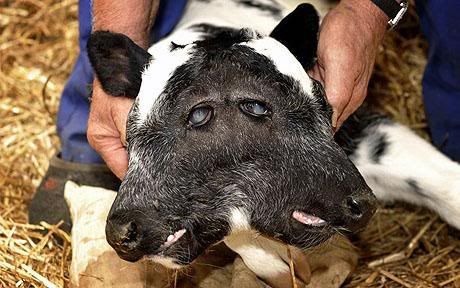
Mr Collard oversaw what he expected to be a normal birth with the help of a local vet at his farm in Flamisoul, Belgium, last week.
But he got more than he bargained for. The mutant has two separate heads but only one brain, meaning both heads react simultaneously.
It also has four eyes and two mouths but only one pair of ears.
Surprised Mr Collard said: "I called the vet because when my cow was in labour, I noticed the birth might get complicated. The calf seemed too big.
"The legs came out first, so we put a rope around them and pulled the calf out, as usual.
"But then the vet cried out: 'It has two heads!'"
"I immediately thought: 'what an exit present for me, I'm thinking about retiring and now this happens'."
"After an hour, I could slowly give it a bottle of milk. That's when I noticed both tongues react at the same time. The vet later explained this is due to the fact that the calf only has one brain.
"I hope it goes well with my new calf, I'm already attached to it, it's like a baby to me. And I see the mother is also crazy about her."
The mother and calf are presently both well but the future of the calf is uncertain.
source....
Thursday, August 20, 2009
Elroy-Sparta State Trail Conditions
The trail is in good condition. Baltimore orioles, indigo buntings and rose breasted grosbeaks can be seen.
The Sparta Depot, Kendall Depot, Elroy Commons and both walk-in campgrounds are all open.
Children enjoy exploring the caboose in the village of Wilton. Wilton is three miles east of Tunnel #2.
Bikers age 16 and older must purchase a pass before riding the trail. State trail passes can be purchased at the Kendall Depot/Trail Headquarters; (608) 463-7109, the Sparta Depot; (888) 540-8434 and other vendors along the trail. A listing of pass vendors is posted in each town.
source....
The Sparta Depot, Kendall Depot, Elroy Commons and both walk-in campgrounds are all open.
Children enjoy exploring the caboose in the village of Wilton. Wilton is three miles east of Tunnel #2.
Bikers age 16 and older must purchase a pass before riding the trail. State trail passes can be purchased at the Kendall Depot/Trail Headquarters; (608) 463-7109, the Sparta Depot; (888) 540-8434 and other vendors along the trail. A listing of pass vendors is posted in each town.
source....
"400" State Trail Conditions
The trail is in good condition. Green-headed coneflower, beebalm, tall bellflower, ironweed, and joe-pye weed are blooming.
If you are looking for a little more adventure, consider canoeing the Baraboo River one way and biking back. A canoe trip from the canoe landing in Union Center to Wonewoc is 3 hours. Shuttle service and rental is availablle in Wonewoc.
The trail corridor is open to horses for 7 miles between Wonewoc and La Valle. Horses must stay on the grassy portion and are not allowed on the limestone surface, except to cross bridges.
Bikers and horseback riders age 16 and older must purchase a pass before riding the trail. State trail passes can be purchased at the Reedsburg Depot/Trail Headquarters; (800) 844-3507, Elroy Commons; (888) 606-2453 and other vendors along the trail. A listing of pass vendors is posted in each town.
source....
If you are looking for a little more adventure, consider canoeing the Baraboo River one way and biking back. A canoe trip from the canoe landing in Union Center to Wonewoc is 3 hours. Shuttle service and rental is availablle in Wonewoc.
The trail corridor is open to horses for 7 miles between Wonewoc and La Valle. Horses must stay on the grassy portion and are not allowed on the limestone surface, except to cross bridges.
Bikers and horseback riders age 16 and older must purchase a pass before riding the trail. State trail passes can be purchased at the Reedsburg Depot/Trail Headquarters; (800) 844-3507, Elroy Commons; (888) 606-2453 and other vendors along the trail. A listing of pass vendors is posted in each town.
source....
Black River State Forest Conditions
Conditions as of Wednesday, August 19, 2009:
All-terrain Vehicle (ATV) Trails
Work continues on upgrading the wetland crossings on a 1.1-mile section of trail from Wildcat Road heading west. This section of trail will be closed during the week for construction. The trail will open by 4 p.m. each Friday for weekend riding. We expect to complete this work by the end of August. This will likely be the last trail project until next spring.
An example of a recently upgraded section of trail can be found North of the Highway 54 parking lot to Bartos road. These projects will protect the long-term sustainability of the trail system and lessen the frequency of trail closings due to large rainfalls. Over the course of the next two years we hope to upgrade all wetland crossings on the property.
The entire trail system has been groomed within the last two weeks and trails are in good condition.
source....
All-terrain Vehicle (ATV) Trails
Work continues on upgrading the wetland crossings on a 1.1-mile section of trail from Wildcat Road heading west. This section of trail will be closed during the week for construction. The trail will open by 4 p.m. each Friday for weekend riding. We expect to complete this work by the end of August. This will likely be the last trail project until next spring.
An example of a recently upgraded section of trail can be found North of the Highway 54 parking lot to Bartos road. These projects will protect the long-term sustainability of the trail system and lessen the frequency of trail closings due to large rainfalls. Over the course of the next two years we hope to upgrade all wetland crossings on the property.
The entire trail system has been groomed within the last two weeks and trails are in good condition.
source....
ISS Tomorrow Morning
21 Aug -3.3 04:17:11 ESE 73
- Quads, hailing from Grand Marsh Observatory atop Elk Castle Hill
- Quads, hailing from Grand Marsh Observatory atop Elk Castle Hill
Delphinus, the dolphin, Karen's favorite constellation
The Milky Way cuts the sky almost in half on August nights. To its east is an area known as "the sea" because many of its constellations are named for sea creatures. One example is Delphinus, the dolphin, which is on the edge of the Milky Way.
- Quads, hailing from Grand Marsh Observatory atop Elk Castle Hill
- Quads, hailing from Grand Marsh Observatory atop Elk Castle Hill
Wednesday, August 19, 2009
Wood stove ban could go to court
Bylaw prohibits their installation; Lawsuit contends that city did not present sound, reliable scientific data
The city of Montreal will be forced to go before Quebec Superior Court to defend its recent ban on the installation of new wood-burning stoves after a lawsuit was filed against the city last Thursday.
"It's always been a question of public health for the Tremblay administration," said Alan DeSousa, executive committee member of the city of Montreal. "We went through exhaustive public consultations over three days and the bylaw was given majority support from the public and was passed unanimously at Council. That's how any democracy works."
The lawsuit is being filed by the Association des professionnels du chauffage, which represents 225 Quebec businesses that make, distribute, sell and maintain wood-burning stoves and related products, and Montreal residents Ghyslain Bélanger and Jose Canelho, who want to install or modify wood-burning stoves in their homes.
The lawsuit contends that the city "did not present any sound, reliable scientific study" as part of the process which led to the ban.
"No scientific expertise was presented demonstrating that the ban on new installations would have a positive effect on air quality."
However, DeSousa stated that representatives from Montreal's Public Health Department attended the public consultation hearings and presented facts and medical studies, including the science behind the impact of the fine particles on human health.
"They went through a fairly exhaustive presentation," DeSousa said. "All of which is available as public record."
The bylaw, which was adopted by city council on April 27, regulates the installation of new wood burning stoves.
"The types of stoves now permitted use wood pellets, natural gas, propane or electricity," DeSousa explained. "Where ever someone is building a new home or is modifying their home, they would be required to comply with the bylaw. The required stoves are already on the market and people have a wide choice of available products."
According to the city's last annual report on air quality, 67 out of 68 bad air quality days in 2008 were caused by particulate matter, which is released in chimney smoke. These fine particles are dangerous because they become imbedded deep in the lungs. In addition to causing over 6,000 cases of bronchitis in Montreal children annually, Health Canada stated that about 1,540 people die prematurely each year in Montreal because of air pollution.
The lawsuit contends "it has been clearly and scientifically demonstrated" that such a ban "in no way contributes to the improvement on air quality."
It is asking the court to suspend the bylaw until a final judgment has been rendered, and to ultimately have the bylaw reversed.
DeSousa said the city of Montreal won't back down.
"We want to be able to protect the health of our population," DeSousa said. "We believe that this bylaw is appropriate for our community and in the city's best interest."
As for the implications the ban has on the wood-burning stove industry in Montreal, DeSousa said "they can sell their products elsewhere, the market is quite large. What we're concerned about is what is installed in Montreal, and how it effects our population."
source....
The city of Montreal will be forced to go before Quebec Superior Court to defend its recent ban on the installation of new wood-burning stoves after a lawsuit was filed against the city last Thursday.
"It's always been a question of public health for the Tremblay administration," said Alan DeSousa, executive committee member of the city of Montreal. "We went through exhaustive public consultations over three days and the bylaw was given majority support from the public and was passed unanimously at Council. That's how any democracy works."
The lawsuit is being filed by the Association des professionnels du chauffage, which represents 225 Quebec businesses that make, distribute, sell and maintain wood-burning stoves and related products, and Montreal residents Ghyslain Bélanger and Jose Canelho, who want to install or modify wood-burning stoves in their homes.
The lawsuit contends that the city "did not present any sound, reliable scientific study" as part of the process which led to the ban.
"No scientific expertise was presented demonstrating that the ban on new installations would have a positive effect on air quality."
However, DeSousa stated that representatives from Montreal's Public Health Department attended the public consultation hearings and presented facts and medical studies, including the science behind the impact of the fine particles on human health.
"They went through a fairly exhaustive presentation," DeSousa said. "All of which is available as public record."
The bylaw, which was adopted by city council on April 27, regulates the installation of new wood burning stoves.
"The types of stoves now permitted use wood pellets, natural gas, propane or electricity," DeSousa explained. "Where ever someone is building a new home or is modifying their home, they would be required to comply with the bylaw. The required stoves are already on the market and people have a wide choice of available products."
According to the city's last annual report on air quality, 67 out of 68 bad air quality days in 2008 were caused by particulate matter, which is released in chimney smoke. These fine particles are dangerous because they become imbedded deep in the lungs. In addition to causing over 6,000 cases of bronchitis in Montreal children annually, Health Canada stated that about 1,540 people die prematurely each year in Montreal because of air pollution.
The lawsuit contends "it has been clearly and scientifically demonstrated" that such a ban "in no way contributes to the improvement on air quality."
It is asking the court to suspend the bylaw until a final judgment has been rendered, and to ultimately have the bylaw reversed.
DeSousa said the city of Montreal won't back down.
"We want to be able to protect the health of our population," DeSousa said. "We believe that this bylaw is appropriate for our community and in the city's best interest."
As for the implications the ban has on the wood-burning stove industry in Montreal, DeSousa said "they can sell their products elsewhere, the market is quite large. What we're concerned about is what is installed in Montreal, and how it effects our population."
source....
The Moon is absent from the sky
The Moon is absent from the sky tonight because it is "new" at 5:02 a.m. CDT tomorrow as it crosses the line between Earth and Sun. It will return to view as a thin crescent in the western sky after sunset by Friday or Saturday.
- Quads, hailing from Grand Marsh Observatory atop Elk Castle Hill
- Quads, hailing from Grand Marsh Observatory atop Elk Castle Hill
ISS Tomorrow Morning
20 Aug -2.5 05:24:35 W 42
- Quads, hailing from Grand Marsh Observatory atop Elk Castle Hill
- Quads, hailing from Grand Marsh Observatory atop Elk Castle Hill
Tuesday, August 18, 2009
ISS Tomorrow Morning
19 Aug -3.3 05:00:23 SW 71
- Quads, hailing from Grand Marsh Observatory atop Elk Castle Hill
- Quads, hailing from Grand Marsh Observatory atop Elk Castle Hill
SONY UNVEILS PARTY-SHOT: AN AUTOMATIC PHOTOGRAPHER

Sony introduced the Party-shot™ personal photographer (model IPT-DS1)—an innovative camera dock that pans 360 degrees and tilts 24 degrees, automatically detects faces, adjusts composition and takes photos for you.
The Party-shot camera accessory uses the camera's BIONZ™ image processor with its Face Detection and Smile Shutter™ features to take photos without the user needing to snap the shutter button. This device makes it easy to capture more natural expressions and fun, candid moments of you, your family and friends without having to hire a photographer.
“With the Party-shot personal photographer, you no longer have to worry about taking photos when you are with your family or friends,” said Shigehiko Nakayama, manager of the digital imaging accessories business at Sony Electronics. “Party-shot captures candid moments that tell natural life stories and also offers a new style of photography that enriches time with your family and friends.”
Compatible with the DSC-WX1 and DSC-TX1 Cyber-shot® digital cameras, the Party-shot camera accessory is mountable on nearly any tripod, so you can set it up in a convenient location in your home, especially when you are entertaining. With two AA batteries, the Party-shot camera accessory captures photos for up to 11 hours and is portable, so you can enjoy taking pictures outdoors. You can also use an AC adaptor (sold separately).
Pre-orders will begin on August 6, 2009, at www.sonystyle.com/retail and at selected retailers nationwide. The Party-shot camera accessory will be available for about $150 in September at Sony Style® retail stores (www.sonystyle.com/retail) and at authorized dealers.
Key Features:
* Automatic
Snaps pictures at an event - automatically.
* Intelligent
Intelligently searches and tilts to follow subjects and take photos.
* Dual Shooting Modes
Smile ShutterTM technology automatically detects smiles and Face Detection technology recognizes faces to take photos at the right moment.
* Composition
Intelligent composition uses the rule of thirds to compose great shots.
* Motion Detection
Motion detection seeks out movement to take photos at the right moment.
* Customize
With one touch of the Menu button, you can set the Rotation Angle, Shooting Frequency, and Flash.
* Flexible Power
Power up your Party-shot with either two AA alkaline batteries, or with the AC adaptor (AC-LS5 or ACS5K), sold separately and not included.
source....
Monday, August 17, 2009
The constellation Lyra
The constellation Lyra, the harp, stands high in the sky as night falls this month. It's marked by its brightest star, Vega, which is one of the five brightest stars in the entire night sky.
- Quads, hailing from Grand Marsh Observatory atop Elk Castle Hill
- Quads, hailing from Grand Marsh Observatory atop Elk Castle Hill
26 Point Buck: Horicon area pair alleged to have poached trophy deer
HORICON – Two Horicon area men face seven conservation charges of illegally shooting a trophy deer out-of-season, stemming from an investigation that began last January.
DNR conservation warden Paul Nell, Horicon, said the charges could cost Wayne Nisiewicz, 45, and Anthony Nisiewicz, 24, hefty fines, jail time and possible loss of their hunting and fishing privileges, if convicted.
Most of the charges stem from the alleged shooting of a deer with a firearm during the archery season. Anthony Nisiewicz was additionally charged with providing false deer registration information while Wayne Nisiewicz was also charged with obstructing a conservation warden.
The investigation was launched when citizens called the wardens about several suspicious gun shots that occurred after dark on Dec. 31, 2008. A subsequent search of the Wayne Nisiewicz property revealed a number of items that led to the charges.
The focal point is the alleged shooting of a large 26 point buck, which is reported to be the largest white-tail buck ever killed in Dodge County.
According to the Dodge County District Attorney’s Office, a criminal complaint is nothing more than a written, formal accusation against a defendant charging the commission of one or more criminal acts. It is not considered as evidence against the defendant in any way. It does not raise any inference of guilt.
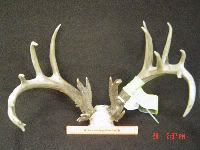
source....
DNR conservation warden Paul Nell, Horicon, said the charges could cost Wayne Nisiewicz, 45, and Anthony Nisiewicz, 24, hefty fines, jail time and possible loss of their hunting and fishing privileges, if convicted.
Most of the charges stem from the alleged shooting of a deer with a firearm during the archery season. Anthony Nisiewicz was additionally charged with providing false deer registration information while Wayne Nisiewicz was also charged with obstructing a conservation warden.
The investigation was launched when citizens called the wardens about several suspicious gun shots that occurred after dark on Dec. 31, 2008. A subsequent search of the Wayne Nisiewicz property revealed a number of items that led to the charges.
The focal point is the alleged shooting of a large 26 point buck, which is reported to be the largest white-tail buck ever killed in Dodge County.
According to the Dodge County District Attorney’s Office, a criminal complaint is nothing more than a written, formal accusation against a defendant charging the commission of one or more criminal acts. It is not considered as evidence against the defendant in any way. It does not raise any inference of guilt.

source....
Sunday, August 16, 2009
ISS Tomorrow Morning
17 Aug -3.1 05:44:23 SW 66
- Quads, hailing from Grand Marsh Observatory atop Elk Castle Hill
- Quads, hailing from Grand Marsh Observatory atop Elk Castle Hill
HA HA HA HA!
A Mauston man was taken into custody early Thursday morning. Police said about 2am.....31-year old Patrick McGregor climbed the light pole behind Randall's Uptown Bar in downtown Mauston and punched the hard plastic/glass cover injuring his hand. After being cleared at the ER at Hess Memorial Hospital...McGregor was transported to the Juneau County Jail and tentatively charged with disorderly conduct.
source....
source....
Saturday, August 15, 2009
News From The Observatory - I Never Intended To Take A Picture
Lake Tomah drawdown and restoration to begin September 8
TOMAH – The state Department of Natural Resources is urging Lake Tomah residents to prepare for lower water levels. The long-planned drawdown of the urban impoundment is scheduled to begin Tuesday, Sept. 8.
Boats moored near docks may become stranded as water levels drop. Lake residents are being asked to remove their boats from the lake before it begins to recede.
The drawdown begins the process of restoring aquatic vegetation and healthy game fish populations to what is now a carp-infested lake nearly devoid of native plant life.
After drawdown, a chemical treatment (rotenone) will eliminate any remaining fish. Lowering the lake level by several feet will reduce water volume and concentrate the remaining fish to increase the effectiveness of the treatment. This past February, the DNR removed size and bag limits on game fish so fishermen could harvest as many fish as possible before the treatment.
The drawdown will take about three weeks. Treatment is scheduled to begin Monday, Oct. 5, and continue through that Friday, depending on weather. During treatment no one will be allowed to use the lake for any purpose. Pets should not be allowed to drink from the lake during treatment.
After treatment, Lake Tomah will be refilled to a level 3 feet below normal where it will be held over winter and into the spring. This will consolidate exposed sediments, allow vegetation to take root and facilitate habitat improvement projects.
DNR fisheries staff will begin stocking game fish this fall and continue stocking in the spring, restoring populations of northern pike, largemouth bass, bluegill and black crappie. New size and bag limits will allow these game fish to re-establish sustainable populations.
source....
Boats moored near docks may become stranded as water levels drop. Lake residents are being asked to remove their boats from the lake before it begins to recede.
The drawdown begins the process of restoring aquatic vegetation and healthy game fish populations to what is now a carp-infested lake nearly devoid of native plant life.
After drawdown, a chemical treatment (rotenone) will eliminate any remaining fish. Lowering the lake level by several feet will reduce water volume and concentrate the remaining fish to increase the effectiveness of the treatment. This past February, the DNR removed size and bag limits on game fish so fishermen could harvest as many fish as possible before the treatment.
The drawdown will take about three weeks. Treatment is scheduled to begin Monday, Oct. 5, and continue through that Friday, depending on weather. During treatment no one will be allowed to use the lake for any purpose. Pets should not be allowed to drink from the lake during treatment.
After treatment, Lake Tomah will be refilled to a level 3 feet below normal where it will be held over winter and into the spring. This will consolidate exposed sediments, allow vegetation to take root and facilitate habitat improvement projects.
DNR fisheries staff will begin stocking game fish this fall and continue stocking in the spring, restoring populations of northern pike, largemouth bass, bluegill and black crappie. New size and bag limits will allow these game fish to re-establish sustainable populations.
source....
Friday, August 14, 2009
Wisconsin Tree Farmer of the Year
CAMBRIDGE – Joe Arington has been selected as the 2009 Wisconsin Tree Farmer of the Year. The Tree Farmer of the Year honor recognizes private landowners who do an exceptional job of both managing their forests and promoting sound forest management.
“It’s exciting” said the owner of Arington Tree Farm, 2935 Evergreen Rd., Cambridge upon his selection by the Wisconsin Tree Farm Committee, based out of Waupaca. The Committee is made up of individuals from industry, consulting foresters, past winners, state Department of Natural Resources staff and woodland owners.
Mr. Arington will be recognized at the annual Wisconsin Woodland Owners Association (WWOA) convention in Stevens Point next month. He will receive county, district and state plaques, along with a gift certificate from Stihl for a chain saw and safety gear.
The Cambridge man was nominated for the award by Charles Brooks, a forester with Christie Forestry Consultants, Madison, with whom he has worked on numerous projects since 2001 and who will present the awards. Mr. Arington also receives forestry assistance from DNR forester Mary Ann Buenzow, Janesville.
Mr. Arington bought his first 20 acre parcel of land in 1998 and continued to purchase property up to what now encompasses 360 acres, of which 150 acres is Tree Farm Certified. The rest remains in agriculture.
Timber present on the Arington Tree Farm includes red and white pine, white spruce, oak, hickory, black walnut, other hardwoods as well as some wetland and grassy areas.
“Joe works tirelessly on controlling invasive species, which is a large and ongoing problem,” points out Shirley Bargander, DNR forestry team leader based at Wausau.
These invasive species include buckthorn, honeysuckle, garlic mustard, reed canary grass and box elder. Invasives are removed from all parts of the property, both forested and wetland areas.
Mr. Arington restored wetlands by not only removing invasives, but through planting species such as tamarack and aspen to promote quality wetlands, along with developing 15 ponds on the property.
Pheasants have been released on the tree farm which also has many hiking trails. A large deer exclusion has been built to protect young seedlings from deer damage. He is working with the Walnut Council to establish test plots of chestnut, butternut and walnut. The Walnut Council is holding its annual conference at Madison in 2011 and will use the Arington Tree Farm for a site visit.
“Joe is very committed to improving his land as well as providing an environment where other landowners can visit and educate themselves about progressive tree farming. He takes the role of a good land steward to the next level with his dedication, enthusiasm and foresight and sincerely deserves to be the 2009 Tree Farmer of the Year,” added Ms. Bargander.
source....
“It’s exciting” said the owner of Arington Tree Farm, 2935 Evergreen Rd., Cambridge upon his selection by the Wisconsin Tree Farm Committee, based out of Waupaca. The Committee is made up of individuals from industry, consulting foresters, past winners, state Department of Natural Resources staff and woodland owners.
Mr. Arington will be recognized at the annual Wisconsin Woodland Owners Association (WWOA) convention in Stevens Point next month. He will receive county, district and state plaques, along with a gift certificate from Stihl for a chain saw and safety gear.
The Cambridge man was nominated for the award by Charles Brooks, a forester with Christie Forestry Consultants, Madison, with whom he has worked on numerous projects since 2001 and who will present the awards. Mr. Arington also receives forestry assistance from DNR forester Mary Ann Buenzow, Janesville.
Mr. Arington bought his first 20 acre parcel of land in 1998 and continued to purchase property up to what now encompasses 360 acres, of which 150 acres is Tree Farm Certified. The rest remains in agriculture.
Timber present on the Arington Tree Farm includes red and white pine, white spruce, oak, hickory, black walnut, other hardwoods as well as some wetland and grassy areas.
“Joe works tirelessly on controlling invasive species, which is a large and ongoing problem,” points out Shirley Bargander, DNR forestry team leader based at Wausau.
These invasive species include buckthorn, honeysuckle, garlic mustard, reed canary grass and box elder. Invasives are removed from all parts of the property, both forested and wetland areas.
Mr. Arington restored wetlands by not only removing invasives, but through planting species such as tamarack and aspen to promote quality wetlands, along with developing 15 ponds on the property.
Pheasants have been released on the tree farm which also has many hiking trails. A large deer exclusion has been built to protect young seedlings from deer damage. He is working with the Walnut Council to establish test plots of chestnut, butternut and walnut. The Walnut Council is holding its annual conference at Madison in 2011 and will use the Arington Tree Farm for a site visit.
“Joe is very committed to improving his land as well as providing an environment where other landowners can visit and educate themselves about progressive tree farming. He takes the role of a good land steward to the next level with his dedication, enthusiasm and foresight and sincerely deserves to be the 2009 Tree Farmer of the Year,” added Ms. Bargander.
source....
Polaris Recalls Ranger Side-by-Side Vehicles Due to Fire Hazard
The following product safety recall was voluntarily conducted by the firm in cooperation with the CPSC. Consumers should stop using the product immediately unless otherwise instructed.
Products: 2009 Polaris Ranger “Crew” and “6x6” Side-by-Side Recreational Vehicles
Units: About 3,800
Importer: Polaris Industries Inc., of Medina, Minn.
Hazard: An electrical short can lead to overheating in the rear tail light wiring harnesses, posing a fire hazard to consumers.
Incidents/Injuries: The firm has received 46 reports of overheating in the vehicle’s tail light area, resulting in melting of plastic. In 22 of these reports, consumers reported small flames. No injuries have been reported.
Description: The recall involves certain 2009 Polaris Ranger side-by-side, off-road vehicles. The model and serial number identification decal is located under the front seat, on the right-side seat support. The recall includes the models listed below:
Model Numbers Model Name
R09RF68AF Ranger 6x6
R09RF68AR Ranger 6x6
R09WH68AC Ranger Crew 4x4
R09WH68AG Ranger Crew 4x4
R09WH68AL Ranger Crew 4x4
R09WH68AR Ranger Crew 4x4
R09WH68AZ Ranger Crew 4x4
Sold at: Polaris dealers nationwide from December 2008 through July 2009 for about $11,500.
Manufactured in: United States
Remedy: Consumers should stop using the recalled vehicles immediately and contact any Polaris Ranger dealer to schedule a free repair. Polaris has notified registered consumers directly about this recall.
Consumer Contact: For further information, contact Polaris toll-free at (888) 704-5290 between 8 a.m. and 5 p.m. CT Monday through Friday or visit the company's Web site at www.polarisindustries.com.
CPSC is still interested in receiving incident or injury reports that are either directly related to this product recall or involve a different hazard with the same product. Please tell us about it by visiting https://www.cpsc.gov/cgibin/incident.aspx.
The U.S. Consumer Product Safety Commission is charged with protecting the public from unreasonable risks of serious injury or death from thousands of types of consumer products under the agency's jurisdiction. The CPSC is committed to protecting consumers and families from products that pose a fire, electrical, chemical, or mechanical hazard. The CPSC's work to ensure the safety of consumer products - such as toys, cribs, power tools, cigarette lighters, and household chemicals - contributed significantly to the decline in the rate of deaths and injuries associated with consumer products over the past 30 years.
To report a dangerous product or a product-related injury, call CPSC's Hotline at (800) 638-2772 or CPSC's teletypewriter at (800) 638-8270. To join a CPSC e-mail subscription list, please go to https://www.cpsc.gov/cpsclist.aspx. Consumers can obtain recall and general safety information by logging on to CPSC's Web site at www.cpsc.gov.
source....
Products: 2009 Polaris Ranger “Crew” and “6x6” Side-by-Side Recreational Vehicles
Units: About 3,800
Importer: Polaris Industries Inc., of Medina, Minn.
Hazard: An electrical short can lead to overheating in the rear tail light wiring harnesses, posing a fire hazard to consumers.
Incidents/Injuries: The firm has received 46 reports of overheating in the vehicle’s tail light area, resulting in melting of plastic. In 22 of these reports, consumers reported small flames. No injuries have been reported.
Description: The recall involves certain 2009 Polaris Ranger side-by-side, off-road vehicles. The model and serial number identification decal is located under the front seat, on the right-side seat support. The recall includes the models listed below:
Model Numbers Model Name
R09RF68AF Ranger 6x6
R09RF68AR Ranger 6x6
R09WH68AC Ranger Crew 4x4
R09WH68AG Ranger Crew 4x4
R09WH68AL Ranger Crew 4x4
R09WH68AR Ranger Crew 4x4
R09WH68AZ Ranger Crew 4x4
Sold at: Polaris dealers nationwide from December 2008 through July 2009 for about $11,500.
Manufactured in: United States
Remedy: Consumers should stop using the recalled vehicles immediately and contact any Polaris Ranger dealer to schedule a free repair. Polaris has notified registered consumers directly about this recall.
Consumer Contact: For further information, contact Polaris toll-free at (888) 704-5290 between 8 a.m. and 5 p.m. CT Monday through Friday or visit the company's Web site at www.polarisindustries.com.
CPSC is still interested in receiving incident or injury reports that are either directly related to this product recall or involve a different hazard with the same product. Please tell us about it by visiting https://www.cpsc.gov/cgibin/incident.aspx.
The U.S. Consumer Product Safety Commission is charged with protecting the public from unreasonable risks of serious injury or death from thousands of types of consumer products under the agency's jurisdiction. The CPSC is committed to protecting consumers and families from products that pose a fire, electrical, chemical, or mechanical hazard. The CPSC's work to ensure the safety of consumer products - such as toys, cribs, power tools, cigarette lighters, and household chemicals - contributed significantly to the decline in the rate of deaths and injuries associated with consumer products over the past 30 years.
To report a dangerous product or a product-related injury, call CPSC's Hotline at (800) 638-2772 or CPSC's teletypewriter at (800) 638-8270. To join a CPSC e-mail subscription list, please go to https://www.cpsc.gov/cpsclist.aspx. Consumers can obtain recall and general safety information by logging on to CPSC's Web site at www.cpsc.gov.
source....
Thursday, August 13, 2009
The planet Jupiter
The planet Jupiter lines up opposite the Sun this week. It rises around sunset and remains in view all night. It also is closest to Earth for the year, so it shines brightest. It looks like a brilliant star low in the east-southeast at nightfall.
- Quads, hailing from Grand Marsh Observatory atop Elk Castle Hill
- Quads, hailing from Grand Marsh Observatory atop Elk Castle Hill
Mini Helicopter Allows Solo Air Travel

Imagine being able to walk out your door, strap on a small device and fly to work, bypassing all the morning traffic.
It's not as far-fetched as you might think.
New Zealand-based Martin Aircraft unveiled a strap-on mini helicopter designed to travel at a speed of 62 mph for about 31 miles.
"To be able to fly solo in a fixed-wing aircraft can take 15 hours of flight training, but most people wanted to be able to learn to fly the jetpack in a few minutes," inventor Glenn Martin said.
So, for now, adrenaline junkies will be able to get the thrill of flying solo through the air with a smaller version that goes about 6 miles an hour and is in a controlled outdoor area.
"It will still be flying as it's never been done before, just in the confines of a rugby field-type space," Martin Aircraft Company Chief Executive Richard Lauder told the Australian Associated Press. "Just because you have to stay under [6 miles an hour] doesn't mean it won't be an exciting experience."
The cost will be about the same as other outdoor adventures like bungee jumping or skydiving, the company said.
The catch — it will only be available in New Zealand.
The first Martin Jetpack Experience will be set up near the company's Christchurch base early next year, although they say they want to expand to Australia and the United States.
Company officials said the mini-helicopter has been in the making for years, but got international attention last year during a trade show in Wisconsin, when a streamlined version was launched.
When orders started rolling in, the company had to put them on hold temorarily until they could manufacture them for a commericial operation.
"We had to rethink our plan to release it to make it very safe," Lauder said.
Each Martin Jetpack costs about $150,000.
source....
Wednesday, August 12, 2009
Arcturus
Arcturus, the brightest star of Bootes, is high in the west at nightfall and sets by around 1 or 2 in the morning. It's hard to miss because it's one of the brightest stars in the night sky, shining with a pale orange color.
- Quads, hailing from Grand Marsh Observatory atop Elk Castle Hill
- Quads, hailing from Grand Marsh Observatory atop Elk Castle Hill
A Square within a Square
Morgans Hill, Nr Bishop Cannings, Wiltshire. Reported 2nd August.
The location of this formation within this landscaped square is a really wonderful concept. The precision of the design and lay of the crop in this formation is indeed awe-inspiring.

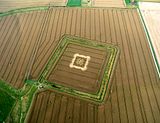
source....


source....
Tuesday, August 11, 2009
Saturn's Rings to Disappear Today
In a celestial feat any magician would appreciate, Saturn will make its wide but thin ring system disappear from our view today.
Saturn's rings, loaded with ice and mud, boulders and tiny moons, is 170,000 miles wide. But the shimmering setup is only about 30 feet thick. The rings harbor 35 trillion-trillion tons of ice, dust and rock, scientists estimate.
The rings shine because they reflect sunlight. But every 15 years, the rings turn edge-on to the sun and reflect almost no sunlight.
"The light reflecting off this extremely narrow band is so small that for all intents and purposes the rings simply vanish," explained Linda Spilker, deputy project scientist for the Cassini Saturn mission at NASA's Jet Propulsion Laboratory.
Mysterious rings
The rings remain a bit of a mystery. Scientists are not sure when or how they formed, though likely a collision of other objects was involved.
Saturn's equator is tilted relative to its orbit around the sun by 27 degrees – similar to the 23-degree tilt of the Earth. As Saturn circles the sun, first one hemisphere and then the other is tilted sunward. This causes seasons on Saturn, just as Earth's tilt causes seasons on our planet.
While Earth goes around the sun once every 365 days or so, Saturn's annual orbit takes 29.7 years. So every 15 years, the attitude shift puts the gas giant planet's equator, and its ring plane, directly in line with sunlight. Scientists call it an equinox, and this one marks the arrival of spring to the giant planet's northern hemisphere. (On Earth, equinoxes occur in March and September.)
"Whenever equinox occurs on Saturn, sunlight will hit Saturn's thin rings, the ring plane, edge-on," Spilker said.
Galileo puzzled
Galileo Galilei was the first to notice the rings and their then-mysterious transformation in the 17th century. Through one of the first telescopes, which he built himself, Galileo discovered Saturn's rings. He didn't know what they were, though, since all he could see were two lobes attached to the planet like ears. He entered the newfound setup in his notebook as a tiny drawing, mid-sentence, to serve as a noun.
By December 1612, Galileo had studied the phenomenon for more than two years, and the lobes (he thought they might be moons) were getting thinner. Then they disappeared.
"I do not know what to say in a case so surprising, so unlooked for and so novel," he wrote in a letter.
Dutch mathematician Christiaan Huygens, using a better telescope, figured out what the rings were in 1655.
"Galileo had every right to be mystified by the rings," Spilker said. "While we know how Saturn pulls off its ring-plane crossing illusion, we are still fascinated and mystified by Saturn's rings, and equinox is a great time for us to learn more."
Up-close view
The edge-on setup casts shadows across the rings in a unique way that can reveal moonlets and other structures otherwise not visible.
NASA's Cassini spacecraft has a front-row seat to the event.
Cassini is watching for topographic features – perhaps some tiny moons or warps in the rings, and it has already spotted some mystery features in the days leading up to the equinox. In one new image, an object seems to have punched through one of the rings, dragging material with it to leave a visible scar. The craft's near-infrared and ultraviolet instruments will be on the hunt for signs of seasonal change on the planet.
"We are not sure what we will find," Spilker said. "Like any great magician, Saturn never fails to impress."
source....
Saturn's rings, loaded with ice and mud, boulders and tiny moons, is 170,000 miles wide. But the shimmering setup is only about 30 feet thick. The rings harbor 35 trillion-trillion tons of ice, dust and rock, scientists estimate.
The rings shine because they reflect sunlight. But every 15 years, the rings turn edge-on to the sun and reflect almost no sunlight.
"The light reflecting off this extremely narrow band is so small that for all intents and purposes the rings simply vanish," explained Linda Spilker, deputy project scientist for the Cassini Saturn mission at NASA's Jet Propulsion Laboratory.
Mysterious rings
The rings remain a bit of a mystery. Scientists are not sure when or how they formed, though likely a collision of other objects was involved.
Saturn's equator is tilted relative to its orbit around the sun by 27 degrees – similar to the 23-degree tilt of the Earth. As Saturn circles the sun, first one hemisphere and then the other is tilted sunward. This causes seasons on Saturn, just as Earth's tilt causes seasons on our planet.
While Earth goes around the sun once every 365 days or so, Saturn's annual orbit takes 29.7 years. So every 15 years, the attitude shift puts the gas giant planet's equator, and its ring plane, directly in line with sunlight. Scientists call it an equinox, and this one marks the arrival of spring to the giant planet's northern hemisphere. (On Earth, equinoxes occur in March and September.)
"Whenever equinox occurs on Saturn, sunlight will hit Saturn's thin rings, the ring plane, edge-on," Spilker said.
Galileo puzzled
Galileo Galilei was the first to notice the rings and their then-mysterious transformation in the 17th century. Through one of the first telescopes, which he built himself, Galileo discovered Saturn's rings. He didn't know what they were, though, since all he could see were two lobes attached to the planet like ears. He entered the newfound setup in his notebook as a tiny drawing, mid-sentence, to serve as a noun.
By December 1612, Galileo had studied the phenomenon for more than two years, and the lobes (he thought they might be moons) were getting thinner. Then they disappeared.
"I do not know what to say in a case so surprising, so unlooked for and so novel," he wrote in a letter.
Dutch mathematician Christiaan Huygens, using a better telescope, figured out what the rings were in 1655.
"Galileo had every right to be mystified by the rings," Spilker said. "While we know how Saturn pulls off its ring-plane crossing illusion, we are still fascinated and mystified by Saturn's rings, and equinox is a great time for us to learn more."
Up-close view
The edge-on setup casts shadows across the rings in a unique way that can reveal moonlets and other structures otherwise not visible.
NASA's Cassini spacecraft has a front-row seat to the event.
Cassini is watching for topographic features – perhaps some tiny moons or warps in the rings, and it has already spotted some mystery features in the days leading up to the equinox. In one new image, an object seems to have punched through one of the rings, dragging material with it to leave a visible scar. The craft's near-infrared and ultraviolet instruments will be on the hunt for signs of seasonal change on the planet.
"We are not sure what we will find," Spilker said. "Like any great magician, Saturn never fails to impress."
source....
Ancient spiders yield 3D secrets
Ancient fossilised, spider-like species have been imaged in 3D using thousands of X-ray scans and imaging software.
The two species, Cryptomartus hindi and Eophrynus prestvicii, lived 300 million years ago but are closely related to modern spiders.
The 3D images show that C. hindi grasped at prey with its front legs and E. prestivicii had defensive spikes on its back.
The results are published in the journal Biology Letters.
The 3D images were obtained by using a computed tomography scanner - a device that can take X-ray images from many angles.
Some 3,000 images of each fossil were obtained, and a custom software package developed at Imperial College London was used to assemble the images into a single, detailed, 3D virtual model of the creatures.
Defensive measures
Those 3D images revealed new detail that previous fossil studies of the animals had not revealed.
C. hindi's front pair of legs, the team found, were angled toward the front, suggesting they were used to grapple with prey.
The researchers suggest that the animal probably was an "ambush predator" like the modern-day crab spider, lying in wait for prey to come close.
Another finding from the models is that E. prestivicii had hard spikes along its back, probably as a defensive measure making it less palatable to the amphibians that would have hunted it.
"Our models almost bring these ancient creatures back to life and it's really exciting to be able to look at them in such detail," said Imperial College London researcher Russel Garwood, lead author on the research.
"Our study helps build a picture of what was happening during this period early in the history of life on land."
The technique could be used to return to fossils that have already been analysed by conventional means, the researchers said.
source....
The two species, Cryptomartus hindi and Eophrynus prestvicii, lived 300 million years ago but are closely related to modern spiders.
The 3D images show that C. hindi grasped at prey with its front legs and E. prestivicii had defensive spikes on its back.
The results are published in the journal Biology Letters.
The 3D images were obtained by using a computed tomography scanner - a device that can take X-ray images from many angles.
Some 3,000 images of each fossil were obtained, and a custom software package developed at Imperial College London was used to assemble the images into a single, detailed, 3D virtual model of the creatures.
Defensive measures
Those 3D images revealed new detail that previous fossil studies of the animals had not revealed.
C. hindi's front pair of legs, the team found, were angled toward the front, suggesting they were used to grapple with prey.
The researchers suggest that the animal probably was an "ambush predator" like the modern-day crab spider, lying in wait for prey to come close.
Another finding from the models is that E. prestivicii had hard spikes along its back, probably as a defensive measure making it less palatable to the amphibians that would have hunted it.
"Our models almost bring these ancient creatures back to life and it's really exciting to be able to look at them in such detail," said Imperial College London researcher Russel Garwood, lead author on the research.
"Our study helps build a picture of what was happening during this period early in the history of life on land."
The technique could be used to return to fossils that have already been analysed by conventional means, the researchers said.
source....
Monday, August 10, 2009
box of dynamite
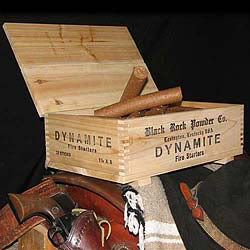
....What initially believed to be a box of dynamite which the Dane County Bomb Squad imploded west of Necedah Friday afternoon....was in reality a novelty box of sticks used for starting fires in fireplaces. Juneau County Undersheriff Craig Stuchlik said the Dane County Bomb Squad researched the origin of the box and determined the novelty sticks can be bought online from the Black Rock Powder Company.
source....
Sunday, August 9, 2009
Home Page Down
The Picture Page is currently down, and has been for about 24 hours. It appears to be an ISP problem and will hopefully be resolved soon.
- Quads, hailing from Grand Marsh Observatory atop Elk Castle Hill
- Quads, hailing from Grand Marsh Observatory atop Elk Castle Hill
The Perseid meteor shower
The Perseid meteor shower is building toward its peak on Tuesday night. Unfortunately, the bright Moon will overpower all but the brightest meteors. The best time to look is after midnight, as your portion of Earth faces into the meteor stream.
- Quads, hailing from Grand Marsh Observatory atop Elk Castle Hill
- Quads, hailing from Grand Marsh Observatory atop Elk Castle Hill
Can Life on Earth Escape the Swelling Sun?
Welcome to the last day on Earth. Humanity's descendants have long since died or fled, oceans have long since vaporized, and the life-giving sun has ballooned into a swollen giant filling the sky.
Scientists have debated for years what will happen to our planet when the sun's fusion furnace begins to run out of fuel and swell into a red giant a few billion years from now. The most recent simulations suggest that Earth will end up being swallowed by the dying sun.
The impending doom is more dire than any fictional villain could ever wish upon a world. Yet the planet need not perish if future civilizations can somehow move Earth out beyond the danger zone. Barring that, a clever escape plan might prove useful.
Red dawn
The fate of life on our planet has always depended upon the sun's destiny. Astrophysicists can trace both the sun's past and future based on their understanding of stellar evolution, which comes from observing stars of many types and at different stages of life.
Larger stars typically meet their end in spectacular supernova explosions, and leave behind either neutron stars or black holes. But mid-size stars like the sun experience a more gradual transformation, after they consume the last of their hydrogen fuel and start burning helium.
Helium burning leads to higher core temperatures that would cause the sun to start swelling into a red giant, around 5 billion years from now. Simulations show the sun eventually expanding to around 250 times its current size.
Previous studies showed that expanding sun would engulf Mercury and Venus, while Mars would remain safely out of reach. But Earth remained in a zone of uncertainty because of its location between those planets. A faint chance existed that the sun would lose too much mass before getting too big, and would allow the Earth to escape into a wider orbit as the sun loses its gravitational grip.
Final sunset
Now any hope for Earth's final salvation may have finally died. British astronomers ran a simulation in early 2008 which included the sun's weakened gravitational pull, and the Earth moving outward in response.
"If that were the only effect, the Earth would indeed escape final destruction," said Robert Smith, emeritus reader at the U.K.'s University of Sussex. "However, the tenuous outer atmosphere of the sun extends a long way beyond its visible surface, and it turns out the Earth would actually be orbiting within these very low density outer layers."
That low-density gas would cause enough drag for the Earth to drift inwards, even as tidal forces caused by the Earth's gravity force the nearest side of the sun to bulge outwards. The Earth eventually drifts into the bulge and ends up vaporized, around 7.6 billion years from now.
However, life has even less time than the planet. Most scientists agree that every living thing faces certain extinction 1 billion years from now, when the sun's growing brightness transforms Earth into a global desert. Dropping carbon dioxide levels would starve plants of the ability to conduct photosynthesis, and that would lead to the inevitable death of all living things.
Life after Earth
A long shot exists for life to survive Earth's fate, but it would involve some novel solutions or a serious space colonization effort.
One team at Santa Cruz University in California has proposed capturing a passing asteroid and using its gravitational effects to "nudge" Earth's orbit outward. A continuous asteroid passage every 6,000 years or so could keep Earth at a comfortable distance and give life another 5 billion years on the planet.
People leery of miscalculations with the asteroid solution could also turn to good old fashioned engineering. Humans may find new homes among the asteroid belt, the outer planets, in artificial colonies, or perhaps beyond this star system. "Space is disease and danger wrapped in darkness and silence," complains Dr. Leonard "Bones" McCoy of "Star Trek," but even life aboard a starship would beat species extinction.
"A safer solution may be to build a fleet of interplanetary 'life rafts' that could maneuver themselves always out of reach of the sun, but close enough to use its energy," Smith suggested.
The sun will eventually lose most of its mass as it becomes a white dwarf, and could come to resemble other burnt-out star systems spotted by NASA's Spitzer Space Telescope in a 2009 study. About 1-3 percent of white dwarf stars seem to contain dust and rocky debris, which may represent remnants of rocky planets such as Earth.
By that time, humanity should have either found its new foothold in the universe or long since ceased to exist.
source....
Scientists have debated for years what will happen to our planet when the sun's fusion furnace begins to run out of fuel and swell into a red giant a few billion years from now. The most recent simulations suggest that Earth will end up being swallowed by the dying sun.
The impending doom is more dire than any fictional villain could ever wish upon a world. Yet the planet need not perish if future civilizations can somehow move Earth out beyond the danger zone. Barring that, a clever escape plan might prove useful.
Red dawn
The fate of life on our planet has always depended upon the sun's destiny. Astrophysicists can trace both the sun's past and future based on their understanding of stellar evolution, which comes from observing stars of many types and at different stages of life.
Larger stars typically meet their end in spectacular supernova explosions, and leave behind either neutron stars or black holes. But mid-size stars like the sun experience a more gradual transformation, after they consume the last of their hydrogen fuel and start burning helium.
Helium burning leads to higher core temperatures that would cause the sun to start swelling into a red giant, around 5 billion years from now. Simulations show the sun eventually expanding to around 250 times its current size.
Previous studies showed that expanding sun would engulf Mercury and Venus, while Mars would remain safely out of reach. But Earth remained in a zone of uncertainty because of its location between those planets. A faint chance existed that the sun would lose too much mass before getting too big, and would allow the Earth to escape into a wider orbit as the sun loses its gravitational grip.
Final sunset
Now any hope for Earth's final salvation may have finally died. British astronomers ran a simulation in early 2008 which included the sun's weakened gravitational pull, and the Earth moving outward in response.
"If that were the only effect, the Earth would indeed escape final destruction," said Robert Smith, emeritus reader at the U.K.'s University of Sussex. "However, the tenuous outer atmosphere of the sun extends a long way beyond its visible surface, and it turns out the Earth would actually be orbiting within these very low density outer layers."
That low-density gas would cause enough drag for the Earth to drift inwards, even as tidal forces caused by the Earth's gravity force the nearest side of the sun to bulge outwards. The Earth eventually drifts into the bulge and ends up vaporized, around 7.6 billion years from now.
However, life has even less time than the planet. Most scientists agree that every living thing faces certain extinction 1 billion years from now, when the sun's growing brightness transforms Earth into a global desert. Dropping carbon dioxide levels would starve plants of the ability to conduct photosynthesis, and that would lead to the inevitable death of all living things.
Life after Earth
A long shot exists for life to survive Earth's fate, but it would involve some novel solutions or a serious space colonization effort.
One team at Santa Cruz University in California has proposed capturing a passing asteroid and using its gravitational effects to "nudge" Earth's orbit outward. A continuous asteroid passage every 6,000 years or so could keep Earth at a comfortable distance and give life another 5 billion years on the planet.
People leery of miscalculations with the asteroid solution could also turn to good old fashioned engineering. Humans may find new homes among the asteroid belt, the outer planets, in artificial colonies, or perhaps beyond this star system. "Space is disease and danger wrapped in darkness and silence," complains Dr. Leonard "Bones" McCoy of "Star Trek," but even life aboard a starship would beat species extinction.
"A safer solution may be to build a fleet of interplanetary 'life rafts' that could maneuver themselves always out of reach of the sun, but close enough to use its energy," Smith suggested.
The sun will eventually lose most of its mass as it becomes a white dwarf, and could come to resemble other burnt-out star systems spotted by NASA's Spitzer Space Telescope in a 2009 study. About 1-3 percent of white dwarf stars seem to contain dust and rocky debris, which may represent remnants of rocky planets such as Earth.
By that time, humanity should have either found its new foothold in the universe or long since ceased to exist.
source....
Saturday, August 8, 2009
Dangerous Cows
The image of cows as placid, gentle creatures is a city slicker’s fantasy, judging from an article published on Friday by the Centers for Disease Control and Prevention, which reports that about 20 people a year are killed by cows in the United States. In some cases, the cows actually attack humans—ramming them, knocking them down, goring them, trampling them and kicking them in the head—resulting in fatal injuries to the head and chest.
Mother cows, like other animals, can be fiercely protective of their young, and dairy bulls, the report notes, are “especially possessive of their herd and occasionally disrupt feeding, cleaning, and milking routines.”
The article, in the Morbidity and Mortality Weekly Report, discusses 21 cases in which people were killed by cattle from 2003 to 2007 in Iowa, Kansas, Missouri and Nebraska.
In 16 cases, “the animal was deemed to have purposefully struck the victim,” the report states. In 5 other cases, people were crushed against walls or by gates shoved by the cattle. Ten of the attacks were by bulls, 6 by cows and 5 by “multiple cattle.” A third of the deaths were caused by animals that had been aggressive in the past.
All but one of the victims died from head or chest injuries; the last died after a cow knocked him down and a syringe in his pocket injected him with an antibiotic meant for the cow. In at least one case the animal attacked from behind, when the person wasn’t looking. Older men with arthritis and hearing aids have the highest risk of being injured by livestock, the report says, probably because they don’t hear the animals charging and can’t move fast enough to get out of the way.
source....
Mother cows, like other animals, can be fiercely protective of their young, and dairy bulls, the report notes, are “especially possessive of their herd and occasionally disrupt feeding, cleaning, and milking routines.”
The article, in the Morbidity and Mortality Weekly Report, discusses 21 cases in which people were killed by cattle from 2003 to 2007 in Iowa, Kansas, Missouri and Nebraska.
In 16 cases, “the animal was deemed to have purposefully struck the victim,” the report states. In 5 other cases, people were crushed against walls or by gates shoved by the cattle. Ten of the attacks were by bulls, 6 by cows and 5 by “multiple cattle.” A third of the deaths were caused by animals that had been aggressive in the past.
All but one of the victims died from head or chest injuries; the last died after a cow knocked him down and a syringe in his pocket injected him with an antibiotic meant for the cow. In at least one case the animal attacked from behind, when the person wasn’t looking. Older men with arthritis and hearing aids have the highest risk of being injured by livestock, the report says, probably because they don’t hear the animals charging and can’t move fast enough to get out of the way.
source....
Three bright stars
Three bright stars highlight the sky this evening. Vega stands high overhead, about 25 light-years away. Yellow-orange Arcturus is in the west, at a distance of 37 light-years. And orange Antares is low in the south, 600 light-years away.
- Quads, hailing from Grand Marsh Observatory atop Elk Castle Hill
- Quads, hailing from Grand Marsh Observatory atop Elk Castle Hill
Friday, August 7, 2009
Mysterious bright spot found on Venus
A strange spot emerged on Venus, and astronomers are not sure what caused it. They hope future observations will reveal whether volcanic activity, turbulence in the planet's atmosphere, or charged particles from the sun are to blame.
Amateur astronomer Frank Melillo of Holtsville, New York, first spotted the new feature, which is brighter than its surroundings at ultraviolet wavelengths, on the planet's southern hemisphere on 19 July. That same day, an amateur observer in Australia found a dark spot on Jupiter that had been caused by a meteoroid impact.
The Venus spot was confirmed by other observers, and images from Europe's Venus Express, the only spacecraft in orbit around the planet, later revealed that the spot had appeared at least four days before Melillo saw it.
Observations show that the spot had already spread out somewhat by the end of last week, and astronomers are awaiting more recent observations from Venus Express.
The spot is bright at ultraviolet wavelengths, which may argue against a meteoroid impact as a cause. That's because rocky bodies, with the exception of objects very rich in water ice, should cause an impact site to darken at ultraviolet wavelengths as it fills with debris that absorbs such light, says Sanjay Limaye of the University of Wisconsin-Madison and a member of the Venus Express team.
Powerful eruption?
Another possibility is that a gust of charged particles from the sun could have created the glow by energising a patch of the upper atmosphere. Alternatively, waves in the atmosphere, which trigger turbulence and are thought to carry material up and down, could have concentrated bright material to create the spot.
A volcanic eruption is another suspect. Venus boasts the most volcanoes of any planet in the solar system, and nearly 90% of its surface is covered by basaltic lava flows, although no 'smoking gun' has yet been found for current volcanic activity. But an eruption would have had to be very powerful to punch through a dense layer in Venus's atmosphere to create the spot some 65 to 70 kilometres above the planet's surface.
"It's fair to say something unusual happened on Venus. Unfortunately, we don't know what happened," Limaye told New Scientist.
Volcanic gases
Two spectrometers on board Venus Express might help reveal the culprit. One directly measures the spectrum of light emanating from the planet, while the other can measure trace constituents in the atmosphere by measuring how gases there absorb sunlight.
These instruments could reveal changes in the size distribution of particles in the atmosphere and higher concentrations of molecules, such as sulphur dioxide, that could suggest a volcanic eruption.
If a volcano is to blame, proving it will be difficult. Even if Venus Express finds higher-than-average levels of sulphur dioxide in the atmosphere, the observation could be explained by non-volcanic processes, cautions Limaye. Sunlight can break down sulphuric acid in Venus's clouds to create sulphur dioxide, which may not be evenly circulated in the planet's atmosphere.
Mystery world
This is not the first time astronomers have spotted bright features in Venus's atmosphere. Bright spots have been seen from Earth for decades, although they have not been clearly explained, Limaye says.
The most recent dramatic brightening occurred in January 2007, when areas in both the northern and southern hemispheres of the planet brightened. Because it is localised in a spot, this new feature looks different, but it is equally mysterious.
"This shows how much we don't know about Venus," Limaye says. In some ways, Venus is a simpler planet than Earth – it has no oceans and because of its nearly vertical spin axis, practically no seasons, he adds. But planetary scientists still do not understand what causes the planet's atmosphere to rotate 60 times faster than the planet itself.
source....
Amateur astronomer Frank Melillo of Holtsville, New York, first spotted the new feature, which is brighter than its surroundings at ultraviolet wavelengths, on the planet's southern hemisphere on 19 July. That same day, an amateur observer in Australia found a dark spot on Jupiter that had been caused by a meteoroid impact.
The Venus spot was confirmed by other observers, and images from Europe's Venus Express, the only spacecraft in orbit around the planet, later revealed that the spot had appeared at least four days before Melillo saw it.
Observations show that the spot had already spread out somewhat by the end of last week, and astronomers are awaiting more recent observations from Venus Express.
The spot is bright at ultraviolet wavelengths, which may argue against a meteoroid impact as a cause. That's because rocky bodies, with the exception of objects very rich in water ice, should cause an impact site to darken at ultraviolet wavelengths as it fills with debris that absorbs such light, says Sanjay Limaye of the University of Wisconsin-Madison and a member of the Venus Express team.
Powerful eruption?
Another possibility is that a gust of charged particles from the sun could have created the glow by energising a patch of the upper atmosphere. Alternatively, waves in the atmosphere, which trigger turbulence and are thought to carry material up and down, could have concentrated bright material to create the spot.
A volcanic eruption is another suspect. Venus boasts the most volcanoes of any planet in the solar system, and nearly 90% of its surface is covered by basaltic lava flows, although no 'smoking gun' has yet been found for current volcanic activity. But an eruption would have had to be very powerful to punch through a dense layer in Venus's atmosphere to create the spot some 65 to 70 kilometres above the planet's surface.
"It's fair to say something unusual happened on Venus. Unfortunately, we don't know what happened," Limaye told New Scientist.
Volcanic gases
Two spectrometers on board Venus Express might help reveal the culprit. One directly measures the spectrum of light emanating from the planet, while the other can measure trace constituents in the atmosphere by measuring how gases there absorb sunlight.
These instruments could reveal changes in the size distribution of particles in the atmosphere and higher concentrations of molecules, such as sulphur dioxide, that could suggest a volcanic eruption.
If a volcano is to blame, proving it will be difficult. Even if Venus Express finds higher-than-average levels of sulphur dioxide in the atmosphere, the observation could be explained by non-volcanic processes, cautions Limaye. Sunlight can break down sulphuric acid in Venus's clouds to create sulphur dioxide, which may not be evenly circulated in the planet's atmosphere.
Mystery world
This is not the first time astronomers have spotted bright features in Venus's atmosphere. Bright spots have been seen from Earth for decades, although they have not been clearly explained, Limaye says.
The most recent dramatic brightening occurred in January 2007, when areas in both the northern and southern hemispheres of the planet brightened. Because it is localised in a spot, this new feature looks different, but it is equally mysterious.
"This shows how much we don't know about Venus," Limaye says. In some ways, Venus is a simpler planet than Earth – it has no oceans and because of its nearly vertical spin axis, practically no seasons, he adds. But planetary scientists still do not understand what causes the planet's atmosphere to rotate 60 times faster than the planet itself.
source....
Thursday, August 6, 2009
News From The Observatory - Moon and Jupiter
Last night's Moon and Jupiter photos:
Jupiter. Camera only, mounted on regular photo tripod. The combination of zoom, exposure length, and regular tripod made Jupiter and it's moons a little egg-shaped. This is a stack of 11 images:

The Moon. Camera and regular photo tripod only. This is not a stack. Photo is single exposure, as it came out of the Canon SX100 camera, resized only for posting here:

The Moon and Jupiter. Camera and regular photo tripod only. This is not a stack. Photo is single exposure, as it came out of the Canon SX100 camera, resized only for posting here. The yummy sweetcorn in the foreground is almost ripe!
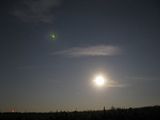
- Quads, hailing from Grand Marsh Observatory atop Elk Castle Hill



- Quads, hailing from Grand Marsh Observatory atop Elk Castle Hill
high speed chase
Law enforcement has been able to identify the operator of a motorcycle who led a Juneau County deputy on a high speed chase through the Village of Necedah last month. According to the criminal complaint....on Monday...17-year old Lee O'Neill was taken into custody at his residence on County Road 'F' in the Town of Finley. Earlier this month...the deputy was able to identify the motorcycle and helmet through an open garage door. O'Neill has been charged with 'attempting to flee or elude a traffic officer' and with '1st degree reckless endangerment'. During a hearing Tuesday...bail was set at a $10,000 signature bond and it must be co-signed by the defendant's mother, Lorraine O'Neill.
source....
source....
Full Moon Names and Their Meanings
Full Moon
names date back to Native Americans, of what is now the northern and eastern United States. The tribes kept track of the seasons by giving distinctive names to each recurring full Moon. Their names were applied to the entire month in which each occurred. There was some variation in the Moon names, but in general, the same ones were current throughout the Algonquin tribes from New England to Lake Superior. European settlers followed that custom and created some of their own names. Since the lunar month is only 29 days long on the average, the full Moon dates shift from year to year. Here is the Farmers Almanac's list of the full Moon names.
• Full Wolf Moon - January Amid the cold and deep snows of midwinter, the wolf packs howled hungrily outside Indian villages. Thus, the name for January's full Moon. Sometimes it was also referred to as the Old Moon, or the Moon After Yule. Some called it the Full Snow Moon, but most tribes applied that name to the next Moon.
• Full Snow Moon - February Since the heaviest snow usually falls during this month, native tribes of the north and east most often called February's full Moon the Full Snow Moon. Some tribes also referred to this Moon as the Full Hunger Moon, since harsh weather conditions in their areas made hunting very difficult.
• Full Worm Moon - March As the temperature begins to warm and the ground begins to thaw, earthworm casts appear, heralding the return of the robins. The more northern tribes knew this Moon as the Full Crow Moon, when the cawing of crows signaled the end of winter; or the Full Crust Moon, because the snow cover becomes crusted from thawing by day and freezing at night. The Full Sap Moon, marking the time of tapping maple trees, is another variation. To the settlers, it was also known as the Lenten Moon, and was considered to be the last full Moon of winter.
• Full Pink Moon - April This name came from the herb moss pink, or wild ground phlox, which is one of the earliest widespread flowers of the spring. Other names for this month's celestial body include the Full Sprouting Grass Moon, the Egg Moon, and among coastal tribes the Full Fish Moon, because this was the time that the shad swam upstream to spawn.
• Full Flower Moon - May In most areas, flowers are abundant everywhere during this time. Thus, the name of this Moon. Other names include the Full Corn Planting Moon, or the Milk Moon.
• Full Strawberry Moon - June This name was universal to every Algonquin tribe. However, in Europe they called it the Rose Moon. Also because the relatively short season for harvesting strawberries comes each year during the month of June . . . so the full Moon that occurs during that month was christened for the strawberry!
• The Full Buck Moon - July July is normally the month when the new antlers of buck deer push out of their foreheads in coatings of velvety fur. It was also often called the Full Thunder Moon, for the reason that thunderstorms are most frequent during this time. Another name for this month's Moon was the Full Hay Moon.
• Full Sturgeon Moon - August The fishing tribes are given credit for the naming of this Moon, since sturgeon, a large fish of the Great Lakes and other major bodies of water, were most readily caught during this month. A few tribes knew it as the Full Red Moon because, as the Moon rises, it appears reddish through any sultry haze. It was also called the Green Corn Moon or Grain Moon.
• Full Corn Moon - September This full moon's name is attributed to Native Americans because it marked when corn was supposed to be harvested. Most often, the September full moon is actually the Harvest Moon.
• Full Harvest Moon - October This is the full Moon that occurs closest to the autumn equinox. In two years out of three, the Harvest Moon comes in September, but in some years it occurs in October. At the peak of harvest, farmers can work late into the night by the light of this Moon. Usually the full Moon rises an average of 50 minutes later each night, but for the few nights around the Harvest Moon, the Moon seems to rise at nearly the same time each night: just 25 to 30 minutes later across the U.S., and only 10 to 20 minutes later for much of Canada and Europe. Corn, pumpkins, squash, beans, and wild rice the chief Indian staples are now ready for gathering.
• Full Beaver Moon - November This was the time to set beaver traps before the swamps froze, to ensure a supply of warm winter furs. Another interpretation suggests that the name Full Beaver Moon comes from the fact that the beavers are now actively preparing for winter. It is sometimes also referred to as the Frosty Moon.
• The Full Cold Moon; or the Full Long Nights Moon - December During this month the winter cold fastens its grip, and nights are at their longest and darkest. It is also sometimes called the Moon before Yule. The term Long Night Moon is a doubly appropriate name because the midwinter night is indeed long, and because the Moon is above the horizon for a long time. The midwinter full Moon has a high trajectory across the sky because it is opposite a low Sun.
source....
names date back to Native Americans, of what is now the northern and eastern United States. The tribes kept track of the seasons by giving distinctive names to each recurring full Moon. Their names were applied to the entire month in which each occurred. There was some variation in the Moon names, but in general, the same ones were current throughout the Algonquin tribes from New England to Lake Superior. European settlers followed that custom and created some of their own names. Since the lunar month is only 29 days long on the average, the full Moon dates shift from year to year. Here is the Farmers Almanac's list of the full Moon names.
• Full Wolf Moon - January Amid the cold and deep snows of midwinter, the wolf packs howled hungrily outside Indian villages. Thus, the name for January's full Moon. Sometimes it was also referred to as the Old Moon, or the Moon After Yule. Some called it the Full Snow Moon, but most tribes applied that name to the next Moon.
• Full Snow Moon - February Since the heaviest snow usually falls during this month, native tribes of the north and east most often called February's full Moon the Full Snow Moon. Some tribes also referred to this Moon as the Full Hunger Moon, since harsh weather conditions in their areas made hunting very difficult.
• Full Worm Moon - March As the temperature begins to warm and the ground begins to thaw, earthworm casts appear, heralding the return of the robins. The more northern tribes knew this Moon as the Full Crow Moon, when the cawing of crows signaled the end of winter; or the Full Crust Moon, because the snow cover becomes crusted from thawing by day and freezing at night. The Full Sap Moon, marking the time of tapping maple trees, is another variation. To the settlers, it was also known as the Lenten Moon, and was considered to be the last full Moon of winter.
• Full Pink Moon - April This name came from the herb moss pink, or wild ground phlox, which is one of the earliest widespread flowers of the spring. Other names for this month's celestial body include the Full Sprouting Grass Moon, the Egg Moon, and among coastal tribes the Full Fish Moon, because this was the time that the shad swam upstream to spawn.
• Full Flower Moon - May In most areas, flowers are abundant everywhere during this time. Thus, the name of this Moon. Other names include the Full Corn Planting Moon, or the Milk Moon.
• Full Strawberry Moon - June This name was universal to every Algonquin tribe. However, in Europe they called it the Rose Moon. Also because the relatively short season for harvesting strawberries comes each year during the month of June . . . so the full Moon that occurs during that month was christened for the strawberry!
• The Full Buck Moon - July July is normally the month when the new antlers of buck deer push out of their foreheads in coatings of velvety fur. It was also often called the Full Thunder Moon, for the reason that thunderstorms are most frequent during this time. Another name for this month's Moon was the Full Hay Moon.
• Full Sturgeon Moon - August The fishing tribes are given credit for the naming of this Moon, since sturgeon, a large fish of the Great Lakes and other major bodies of water, were most readily caught during this month. A few tribes knew it as the Full Red Moon because, as the Moon rises, it appears reddish through any sultry haze. It was also called the Green Corn Moon or Grain Moon.
• Full Corn Moon - September This full moon's name is attributed to Native Americans because it marked when corn was supposed to be harvested. Most often, the September full moon is actually the Harvest Moon.
• Full Harvest Moon - October This is the full Moon that occurs closest to the autumn equinox. In two years out of three, the Harvest Moon comes in September, but in some years it occurs in October. At the peak of harvest, farmers can work late into the night by the light of this Moon. Usually the full Moon rises an average of 50 minutes later each night, but for the few nights around the Harvest Moon, the Moon seems to rise at nearly the same time each night: just 25 to 30 minutes later across the U.S., and only 10 to 20 minutes later for much of Canada and Europe. Corn, pumpkins, squash, beans, and wild rice the chief Indian staples are now ready for gathering.
• Full Beaver Moon - November This was the time to set beaver traps before the swamps froze, to ensure a supply of warm winter furs. Another interpretation suggests that the name Full Beaver Moon comes from the fact that the beavers are now actively preparing for winter. It is sometimes also referred to as the Frosty Moon.
• The Full Cold Moon; or the Full Long Nights Moon - December During this month the winter cold fastens its grip, and nights are at their longest and darkest. It is also sometimes called the Moon before Yule. The term Long Night Moon is a doubly appropriate name because the midwinter night is indeed long, and because the Moon is above the horizon for a long time. The midwinter full Moon has a high trajectory across the sky because it is opposite a low Sun.
source....
Wednesday, August 5, 2009
News From The Observatory - Roche-A-Cri, EAA Planes, Sittin' By The Fire
full Moon has a brilliant companion
The full Moon has a brilliant companion tonight: the planet Jupiter. It's the "star" to the lower left of the Moon as they climb into good view in early evening.
- Quads, hailing from Grand Marsh Observatory atop Elk Castle Hill
- Quads, hailing from Grand Marsh Observatory atop Elk Castle Hill
giant anvil-shaped cloud hovering 75,000ft above Earth is photographed by Space Station astronauts
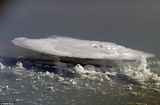
A giant, anvil-shaped cloud bubbles up towards the Earth's stratosphere, looming over West Africa.
The amazing formation would be invisible to anyone on the ground and would even be obscure from a regular passenger jet since they can reach up to 75,000ft.
But astronauts captured the astonishing picture from hundreds of miles up as they orbited the globe on the International Space Station.
Anvil clouds are formed mostly from ice and normally form in the upper parts of thunderstorms. They get their shape from the fact that rising warm air in thunderstorms expands and spreads out as the air bumps up against the bottom of the stratosphere.
Streaks of snow are often seen falling out of the edges of anvils. This light snow usually evaporates as it falls through the relatively dry air surrounding the upper part of the thunderstorm.
source....
Tuesday, August 4, 2009
The Perseids are Coming
Earth is entering a stream of dusty debris from Comet Swift-Tuttle, the source of the annual Perseid meteor shower. Although the shower won't peak until August 11th and 12th, the show is already getting underway.
Don't get too excited, cautions Bill Cooke of NASA's Meteoroid Environment Office. "We're just in the outskirts of the debris stream now. If you go out at night and stare at the sky, you'll probably only see a few Perseids per hour."
This will change, however, as August unfolds.
"Earth passes through the densest part of the debris stream sometime on August 12th. Then, you could see dozens of meteors per hour."
For sky watchers in North America, the watch begins after nightfall on August 11th and continues until sunrise on the 12th. Veteran observers suggest the following strategy: Unfold a blanket on a flat patch of ground. (Note: The middle of your street is not a good choice.) Lie down and look up. Perseids can appear in any part of the sky, their tails all pointing back to the shower's radiant in the constellation Perseus. Get away from city lights if you can.
There is one light you cannot escape on August 12th. The 55% gibbous Moon will glare down from the constellation Aries just next door to the shower's radiant in Perseus. The Moon is beautiful, but don't stare at it. Bright moonlight ruins night vision and it will wipe out any faint Perseids in that part of the sky.
The Moon is least troublesome during the early evening hours of August 11th. Around 9 to 11 p.m. local time (your local time), both Perseus and the Moon will be hanging low in the north. This low profile reduces lunar glare while positioning the shower's radiant for a nice display of Earthgrazers.
"Earthgrazers are meteors that approach from the horizon and skim the atmosphere overhead like a stone skipping across the surface of a pond," explains Cooke. "They are long, slow and colorful—among the most beautiful of meteors." He notes that an hour of watching may net only a few of these at most, but seeing even one can make the whole night worthwhile.
The Perseids are coming. Enjoy the show.
source....
Don't get too excited, cautions Bill Cooke of NASA's Meteoroid Environment Office. "We're just in the outskirts of the debris stream now. If you go out at night and stare at the sky, you'll probably only see a few Perseids per hour."
This will change, however, as August unfolds.
"Earth passes through the densest part of the debris stream sometime on August 12th. Then, you could see dozens of meteors per hour."
For sky watchers in North America, the watch begins after nightfall on August 11th and continues until sunrise on the 12th. Veteran observers suggest the following strategy: Unfold a blanket on a flat patch of ground. (Note: The middle of your street is not a good choice.) Lie down and look up. Perseids can appear in any part of the sky, their tails all pointing back to the shower's radiant in the constellation Perseus. Get away from city lights if you can.
There is one light you cannot escape on August 12th. The 55% gibbous Moon will glare down from the constellation Aries just next door to the shower's radiant in Perseus. The Moon is beautiful, but don't stare at it. Bright moonlight ruins night vision and it will wipe out any faint Perseids in that part of the sky.
The Moon is least troublesome during the early evening hours of August 11th. Around 9 to 11 p.m. local time (your local time), both Perseus and the Moon will be hanging low in the north. This low profile reduces lunar glare while positioning the shower's radiant for a nice display of Earthgrazers.
"Earthgrazers are meteors that approach from the horizon and skim the atmosphere overhead like a stone skipping across the surface of a pond," explains Cooke. "They are long, slow and colorful—among the most beautiful of meteors." He notes that an hour of watching may net only a few of these at most, but seeing even one can make the whole night worthwhile.
The Perseids are coming. Enjoy the show.
source....
Monday, August 3, 2009
Polaris Industries Recalls ATVs Due to Fire Hazard
The following product safety recall was voluntarily conducted by the firm in cooperation with the CPSC. Consumers should stop using the product immediately in subfreezing temperatures unless otherwise instructed.
Name of Product: 2009 Model Year Polaris All-Terrain Vehicles (ATVs)
Units: About 4,700
Manufacturer: Polaris Industries Inc., of Medina, Minn.
Hazard: The crankcase breather valve assembly can fail in freezing temperatures, causing oil to leak onto the exhaust system. This could pose a fire and burn hazard to the rider.
Incidents/Injuries: The firm has received six reports of the crankcase breather valve assembly failing in freezing temperatures, resulting in three small fires. Minor fire damage to air boxes, ignition coils and the seat were reported.
Description: This recall involves the Polaris ATVs with model year 2009. The ATVs were sold under market names Sportsman ESP XP 850 and Sportsman XP 850 ATVs. The model and serial number identification decal is located on the left side of the machine on the frame rail below the front fender. The following models are being recalled:
Market Name Model Name Market Name Model Name
Sportsman ESP XP 850 A09ZX85AG Sportsman XP 850 A09ZN85AL
Sportsman ESP XP 850 A09ZX85AL Sportsman XP 850 A09ZN85AQ
Sportsman ESP XP 850 A09ZX85AQ Sportsman XP 850 A09ZN85AS
Sportsman ESP XP 850 A09ZX85AR Sportsman XP 850 A09ZN85AT
Sportsman ESP XP 850 A09ZX85AS Sportsman XP 850 A09ZN85AX
Sportsman ESP XP 850 A09ZX85AX Sportsman XP 850 A09ZN8XAL
Sportsman ESP XP 850 A09ZX8XAG Sportsman XP 850 A09ZN8XAQ
Sportsman ESP XP 850 A09ZX8XAL Sportsman XP 850 A09ZN8XAS
Sportsman ESP XP 850 A09ZX8XAQ Sportsman XP 850 A09ZN8XAX
Sportsman ESP XP 850 A09ZX8XAR
Sportsman ESP XP 850 A09ZX8XAS
Sportsman ESP XP 850 A09ZX8XAX
Sold at: Polaris dealers nationwide from September 2008 through June 2009 for about $9000.
Manufactured in: United States
Remedy: Consumers should immediately stop using the ATV in sub-freezing temperatures and contact their local Polaris dealer to schedule a free repair. Registered owners have received direct mail notification of this recall if they are likely to experience consistently sub-freezing temperatures.
Consumer Contact: For additional information, contact Polaris toll-free at (888) 704-5290 between 8 a.m. and 5 p.m. CT Monday through Friday, or visit the firm’s Web site at www.polarisindustries.com.
CPSC is still interested in receiving incident or injury reports that are either directly related to this product recall or involve a different hazard with the same product. Please tell us about it by clicking here.
Send the link for this page to a friend! The U.S. Consumer Product Safety Commission is charged with protecting the public from unreasonable risks of serious injury or death from thousands of types of consumer products under the agency's jurisdiction. The CPSC is committed to protecting consumers and families from products that pose a fire, electrical, chemical, or mechanical hazard. The CPSC's work to ensure the safety of consumer products - such as toys, cribs, power tools, cigarette lighters, and household chemicals - contributed significantly to the decline in the rate of deaths and injuries associated with consumer products over the past 30 years.
To report a dangerous product or a product-related injury, call CPSC's Hotline at (800) 638-2772 or CPSC's teletypewriter at (800) 638-8270. To join a CPSC e-mail subscription list, please go to https://www.cpsc.gov/cpsclist.aspx. Consumers can obtain recall and general safety information by logging on to CPSC's Web site at www.cpsc.gov.
source....
Name of Product: 2009 Model Year Polaris All-Terrain Vehicles (ATVs)
Units: About 4,700
Manufacturer: Polaris Industries Inc., of Medina, Minn.
Hazard: The crankcase breather valve assembly can fail in freezing temperatures, causing oil to leak onto the exhaust system. This could pose a fire and burn hazard to the rider.
Incidents/Injuries: The firm has received six reports of the crankcase breather valve assembly failing in freezing temperatures, resulting in three small fires. Minor fire damage to air boxes, ignition coils and the seat were reported.
Description: This recall involves the Polaris ATVs with model year 2009. The ATVs were sold under market names Sportsman ESP XP 850 and Sportsman XP 850 ATVs. The model and serial number identification decal is located on the left side of the machine on the frame rail below the front fender. The following models are being recalled:
Market Name Model Name Market Name Model Name
Sportsman ESP XP 850 A09ZX85AG Sportsman XP 850 A09ZN85AL
Sportsman ESP XP 850 A09ZX85AL Sportsman XP 850 A09ZN85AQ
Sportsman ESP XP 850 A09ZX85AQ Sportsman XP 850 A09ZN85AS
Sportsman ESP XP 850 A09ZX85AR Sportsman XP 850 A09ZN85AT
Sportsman ESP XP 850 A09ZX85AS Sportsman XP 850 A09ZN85AX
Sportsman ESP XP 850 A09ZX85AX Sportsman XP 850 A09ZN8XAL
Sportsman ESP XP 850 A09ZX8XAG Sportsman XP 850 A09ZN8XAQ
Sportsman ESP XP 850 A09ZX8XAL Sportsman XP 850 A09ZN8XAS
Sportsman ESP XP 850 A09ZX8XAQ Sportsman XP 850 A09ZN8XAX
Sportsman ESP XP 850 A09ZX8XAR
Sportsman ESP XP 850 A09ZX8XAS
Sportsman ESP XP 850 A09ZX8XAX
Sold at: Polaris dealers nationwide from September 2008 through June 2009 for about $9000.
Manufactured in: United States
Remedy: Consumers should immediately stop using the ATV in sub-freezing temperatures and contact their local Polaris dealer to schedule a free repair. Registered owners have received direct mail notification of this recall if they are likely to experience consistently sub-freezing temperatures.
Consumer Contact: For additional information, contact Polaris toll-free at (888) 704-5290 between 8 a.m. and 5 p.m. CT Monday through Friday, or visit the firm’s Web site at www.polarisindustries.com.
CPSC is still interested in receiving incident or injury reports that are either directly related to this product recall or involve a different hazard with the same product. Please tell us about it by clicking here.
Send the link for this page to a friend! The U.S. Consumer Product Safety Commission is charged with protecting the public from unreasonable risks of serious injury or death from thousands of types of consumer products under the agency's jurisdiction. The CPSC is committed to protecting consumers and families from products that pose a fire, electrical, chemical, or mechanical hazard. The CPSC's work to ensure the safety of consumer products - such as toys, cribs, power tools, cigarette lighters, and household chemicals - contributed significantly to the decline in the rate of deaths and injuries associated with consumer products over the past 30 years.
To report a dangerous product or a product-related injury, call CPSC's Hotline at (800) 638-2772 or CPSC's teletypewriter at (800) 638-8270. To join a CPSC e-mail subscription list, please go to https://www.cpsc.gov/cpsclist.aspx. Consumers can obtain recall and general safety information by logging on to CPSC's Web site at www.cpsc.gov.
source....
Sunday, August 2, 2009
Four bear hunting dogs killed by wolves from July 19-27
Four new hound training caution areas have been identified in northern Wisconsin in response to the recent killing of hounds being trained to hunt bear.
During the past two weeks, wolves have killed four dogs and injured one dog that were being trained for bear hunting in Bayfield, Burnett, Clark and Oneida counties, officials with the state Department of Natural Resources report.
Investigators from the U.S. Department of Agriculture Wildlife Services confirmed the wolf attacks. They took place south of Port Wing in Bayfield County, south of Rhinelander in Oneida County, northeast of Riverside in Burnett County and west of Neillsville in Clark County.
Adrian Wydeven, DNR mammalian ecologist, said wolves have pups in rendezvous sites at this time of the year. It is probable the wolves were protecting their young.
“We ask bear hunters to exercise greater caution and avoid training or hunting near sites with concentrated wolf activity – hunters should be familiar with caution area maps on the DNR wolf web site,” Wydeven said. All packs involved with dog incidents likely produced pups this spring.
Hunters may train dogs by pursuing bear from July 1 to August 31 each year. The gray wolf currently is listed as a federally endangered species and persons convicted of killing a wolf are subject to possible jail time and fines.
source....
During the past two weeks, wolves have killed four dogs and injured one dog that were being trained for bear hunting in Bayfield, Burnett, Clark and Oneida counties, officials with the state Department of Natural Resources report.
Investigators from the U.S. Department of Agriculture Wildlife Services confirmed the wolf attacks. They took place south of Port Wing in Bayfield County, south of Rhinelander in Oneida County, northeast of Riverside in Burnett County and west of Neillsville in Clark County.
Adrian Wydeven, DNR mammalian ecologist, said wolves have pups in rendezvous sites at this time of the year. It is probable the wolves were protecting their young.
“We ask bear hunters to exercise greater caution and avoid training or hunting near sites with concentrated wolf activity – hunters should be familiar with caution area maps on the DNR wolf web site,” Wydeven said. All packs involved with dog incidents likely produced pups this spring.
Hunters may train dogs by pursuing bear from July 1 to August 31 each year. The gray wolf currently is listed as a federally endangered species and persons convicted of killing a wolf are subject to possible jail time and fines.
source....
Saturday, August 1, 2009
The Resting Place
This is my favorite place to sit and watch the world go by. In between loads of firewood, after the milking is done, and on dark summer nights, you can find me sitting on this bench. It faces east, so as to be warm in the morning and cool in the evening.
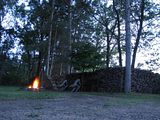
- Quads, hailing from Grand Marsh Observatory atop Elk Castle Hill

- Quads, hailing from Grand Marsh Observatory atop Elk Castle Hill
Road reconstruction project may result in Incidental Take of rare snake
A road improvement project in the Town of Lisbon, Waukesha County may result in the incidental taking of a snake listed as a state threatened species under an authorization the Department of Natural Resources is proposing for the projects.
The Town of Lisbon is proposing to extend the length of an existing culvert at the crossing of Hillside Road over the Bark River on both the east and west sides by 15 feet, respectively, as well as replace and extend the existing end walls. This is being done to provide a safer crossing for pedestrian and bicycle traffic and vehicles traveling on Hillside Road.
The proposed culvert extension will be constructed in habitat that is suitable Butler’s gartersnake (Thamnophis butleri), a species listed as threatened in Wisconsin. The Department of Natural Resources is proposing to authorize the incidental taking of Butler’s gartersnakes resulting from the culvert extension. Incidental take refers to the unintentional loss of individual endangered or threatened animals or plants that does not put the overall population of the species at risk.
The present road width is not adequate at this crossing to allow room for vehicles and safely provide for pedestrian and bike traffic. The proposed improvement to the Hillside Road crossing will provide a greater clear zone beyond the minimum deck of the bridge by lengthening the existing culvert. It will include the placement of fill and a paved shoulder over the extended culvert.
The loss of habitat will be mitigated by providing habitat connectivity for Butler’s gartersnake through a separate culvert upslope from the Bark River. This connectivity will result in an overall gain of available habitat on both sides of the existing culvert, which will ultimately benefit the snake.
DNR staff determined that the proposed project will minimize the impacts to the snake; is not likely to jeopardize the continued existence and recovery of the state population of the snake or the whole plant-animal community of which it is a part; and has benefit to the public health, safety or welfare that justifies the actions.
source....
The Town of Lisbon is proposing to extend the length of an existing culvert at the crossing of Hillside Road over the Bark River on both the east and west sides by 15 feet, respectively, as well as replace and extend the existing end walls. This is being done to provide a safer crossing for pedestrian and bicycle traffic and vehicles traveling on Hillside Road.
The proposed culvert extension will be constructed in habitat that is suitable Butler’s gartersnake (Thamnophis butleri), a species listed as threatened in Wisconsin. The Department of Natural Resources is proposing to authorize the incidental taking of Butler’s gartersnakes resulting from the culvert extension. Incidental take refers to the unintentional loss of individual endangered or threatened animals or plants that does not put the overall population of the species at risk.
The present road width is not adequate at this crossing to allow room for vehicles and safely provide for pedestrian and bike traffic. The proposed improvement to the Hillside Road crossing will provide a greater clear zone beyond the minimum deck of the bridge by lengthening the existing culvert. It will include the placement of fill and a paved shoulder over the extended culvert.
The loss of habitat will be mitigated by providing habitat connectivity for Butler’s gartersnake through a separate culvert upslope from the Bark River. This connectivity will result in an overall gain of available habitat on both sides of the existing culvert, which will ultimately benefit the snake.
DNR staff determined that the proposed project will minimize the impacts to the snake; is not likely to jeopardize the continued existence and recovery of the state population of the snake or the whole plant-animal community of which it is a part; and has benefit to the public health, safety or welfare that justifies the actions.
source....
Subscribe to:
Posts (Atom)



